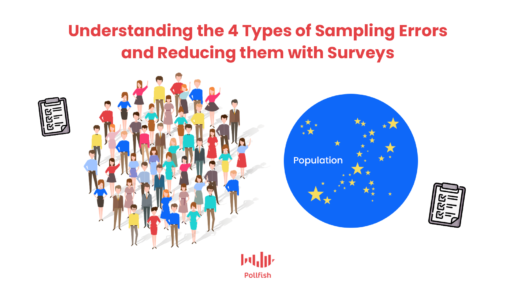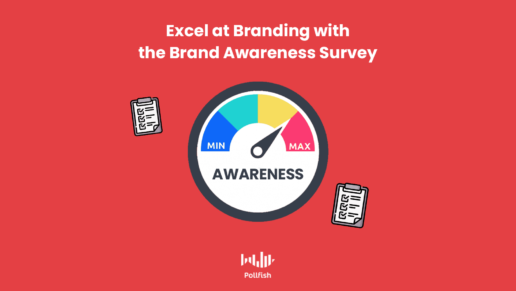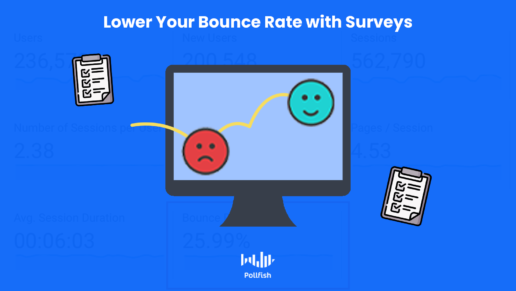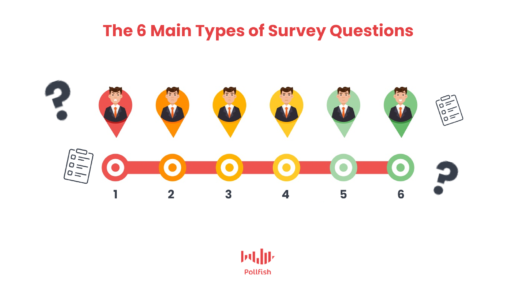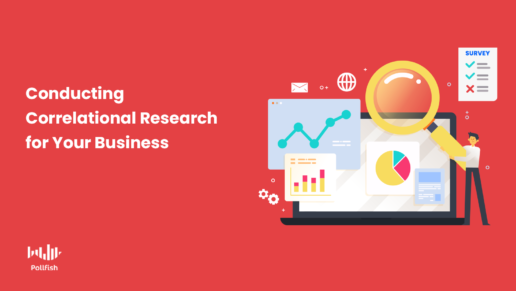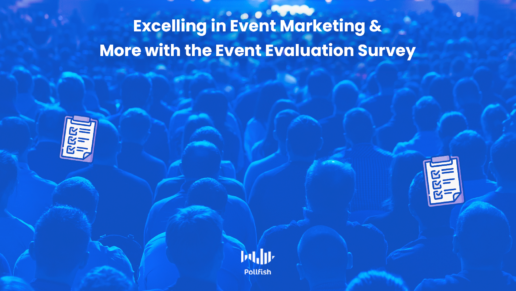How Surveys Help Reduce the 4 Types of Sampling Errors in Market Research
How Surveys Help Reduce the 4 Types of Sampling Errors in Market Research

Market researchers must learn how to grapple with the different types of sampling errors. As one of the major manifestations of the flaws in market research, researchers should be well-aware of what they are and the consequences they carry for market research campaigns.
Although damaging to the effectiveness of your research, the four types of sampling errors aren’t ineradicable. When you are well-versed in their meanings and ramifications, you can better track them. Surveys can help you reduce them, so that your output consists of effective survey studies.
This article explains the four types of sampling errors and how surveys can put them at bay so that you yield the most accurate and quality data.
Understanding Sampling Errors
Sampling errors denote the deviations in the sampling pool data from the data that would actually result from the true population. They occur from the phenomenon in which the sample used is not a genuine representation of a certain population.
Essentially, these errors are the difference between the real values of a population and the values taken from a sampling of the population.
The origin of the errors lies in the collection of data, which then renders the results as invalid.
These are categorized into four types of sampling errors. You can minimize these four types of errors through a number of ways. Using surveys can alleviate these types of sampling errors when used correctly. This is to say that each type of error has its own reduction requirements to be used with surveys.
The Four Types of Sampling Errors
There are four types of sampling errors. The problem with these errors is that they invalidate the results of a survey. In such instances market researchers should calculate the margin of error, as sampling errors are not specific calculations.
Instead, they rely on the margin of error as a measurement of the maximum likely size of your sampling errors. You can use this metric if you use random survey sampling methods.
The following explains each of the four types of sampling errors present in market research.
Selection Error
This error comes about when the survey participation is selected by the respondents themselves, meaning that only those who are interested take part in the survey. A common example of this kind of error is a survey that uses a small portion of respondents who partake immediately.
If a business or the market researchers thereof follow up with the respondents who didn’t initially respond to the survey, the results are bound to see some change. Also, if the researchers overlook the respondents who don’t respond immediately, this too will not reflect the views of the entire target market.
Population Specification Error
This error transpires when market researchers do not know who exactly to include in their sampling. This error emerges when certain niches and more specifically — products, do not have specific members of a target market. For example, sandwich consumers can span across generations and ethnicities.
When the population specification error occurs, it is also due to sampling the wrong population. For example, a company may be launching a new line of handbags, aimed at the younger generation. However, this population may not have the required purchasing power to be consumers. Thus, the company targets slightly older targets. Although they have a higher purchasing power, they have no interest in the handbags.
In this error, the wrong respondents are targeted from a lack of knowing which group(s) would most precisely be of use to survey.
Sample Frame Error
The sample frame error relates to surveying the wrong population in the way that a sample has been selected. Survey biases occur from this error, in that market researchers in this case do not foresee that only certain kinds of respondents would be in their sampling pool, thereby excluding critical members of a target population.
This error includes targeting the wrong segments, or missing out on certain demographics within the correct segments. A few examples of this error include when researchers do not target respondents who:
- use a particular device (iPhone vs Android)
- live in a certain region
- are of a certain income group
By missing the key people in a survey study, it results in sampling a group who does not fully fit or complete a target market or population of a study.
Non-Response Error
This error refers to the issue that results from failing to obtain a useful response in the surveys, in regards to the groups of respondents who take them. This occurs when a common group of people disproportionately partake in a company’s survey studies, instead of all relevant groups, therefore skewing its results.
In the case of this error, other groups who pertain to a survey’s study, such as other target market segments miss the opportunity to offer their data and insights. It can spring from a refusal to complete a survey or take it in the first place.
How the Four Types of Sampling Errors Differ from Non-Sampling Errors
Aside from the four types of sampling errors, other types of errors exist in market research. These are commonly associated with errors that don’t occur due to sampling itself, thereby landing them the name of non-sampling errors.
Non-sampling errors are deviations of estimates from their true values, ones that are not a part of the function of a chosen sample, which includes both random and systematic errors.
Non-sampling errors can spring up in the case of samples and censuses, i.e., when an entire targeted population is surveyed.
Non-sampling errors can also arise within a representative sample, e.g., a national survey, or during total enumeration, e.g., via an employee feedback survey.
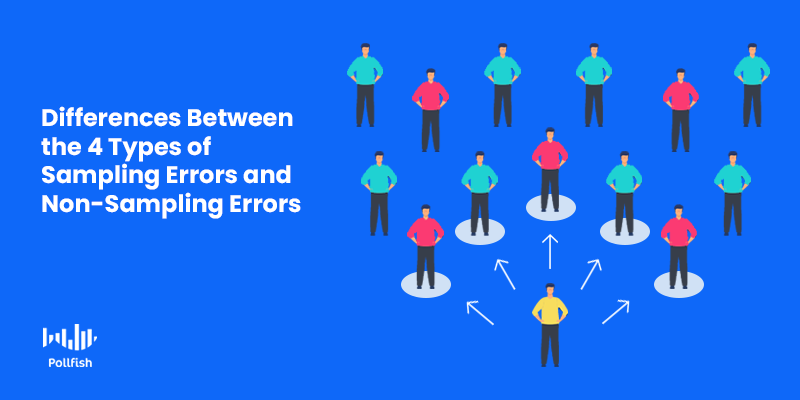
The below explains the ways in which various types of sampling errors differ from non-sampling errors.
- Sampling errors can emerge even when there is no apparent mistake, while non-sampling errors come up due to a mistake.
- Sampling errors dictate a sample that is not representative of a universal truth of a target population, whereas non-sampling errors are particular to a study design.
- You can reduce sampling errors by increasing the sampling size, but non-sampling errors require methodical practices for reduction.
- Internal factors usually cause sampling errors; on the other hand, non-sampling errors occur from external factors not entirely related to a survey, study, or census.
How Surveys Reduce the 4 Types of Sampling Errors
Surveys as a market research mechanism may often be embroiled in the different types of sampling errors. However, when used correctly, they can greatly reduce them. It predominantly depends on the online survey platform you use. The following explains how surveys help reduce the four types of sampling errors.
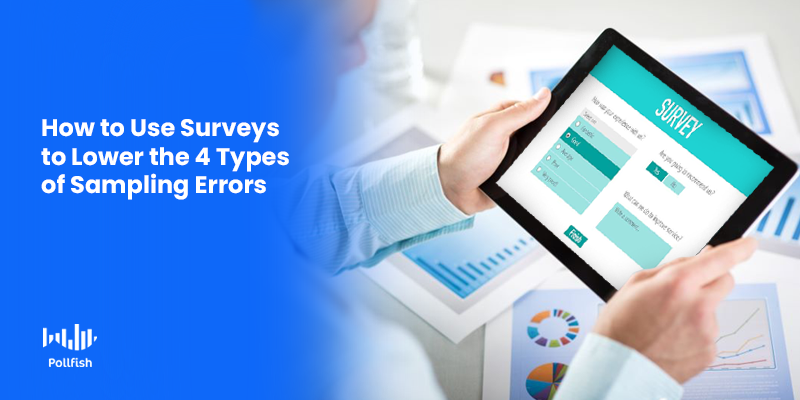
- Selection Error: You can reduce it by encouraging participation.
- The call-out of a survey can help grab res[ondents’ attention and interest.
- A survey’s setup can also help. For example, if site and app users find a survey, they are obviously more likely to take it than those who don’t see it.
- This will depend on the online survey platform you use, along with where you set it up.
- Survey incentives are known to drive up respondent interest in taking a survey.
- Population Specification Error: You can avoid it by having a deep knowledge of your target market and its makeup of sectors.
- Surveys help you to both identify and study your target market, via market segmentation.
- You can learn more about the proper segments for your various market research and marketing campaigns via the target market survey.
- Survey research also completes secondary market research on your target market.
- Sample Frame Error: The proper online survey platform will allow you to not merely identify all the correct members of your target market, but reach them as well.
- It should be set up in a way that makes it nearly impossible to miss the crucial members of your target population.
- Various demographic, psychographic and geographic filters should allow you to include (or include) your intended respondents.
- A survey platform must allow you to target any group, while seeing how various groups are divide, e.g., by device type, operating system, location, etc.
- Non-Response Error: The makeup of the survey and the way it is deployed can cut back on this error.
- A strong online survey tool can ensure potential respondents that the survey is short.
- Such a platform can make surveys more engaging by including various question types so that respondents do not get bored and complete their surveys.
- You can also add multimedia files to weed out boredom.
- Incentives also help net those who are not inclined to take surveys.
Warding off the Four Types of Sampling Errors in all Your Endeavors
Market researchers should always expect the presence of different types of sampling errors; no study can fully encapsulate the opinions and other data of all the members of a target market.
These errors even arise when no mistake is present, making them inevitable.
However, market researchers and general research ought not to fret, because there are ways in which you can significantly minimize these errors. Surveys themselves can help you keep these errors to a minimum.
The effectiveness of using surveys as a method of lessening the four main types of sampling errors depends on both the online survey platform you use and the different best practices you take to ensure their reduction. As such, you should choose platforms that offer relentless quality.
Diving Into the Brand Awareness Survey to Excel in Branding
Diving Into the Brand Awareness Survey to Excel in Branding
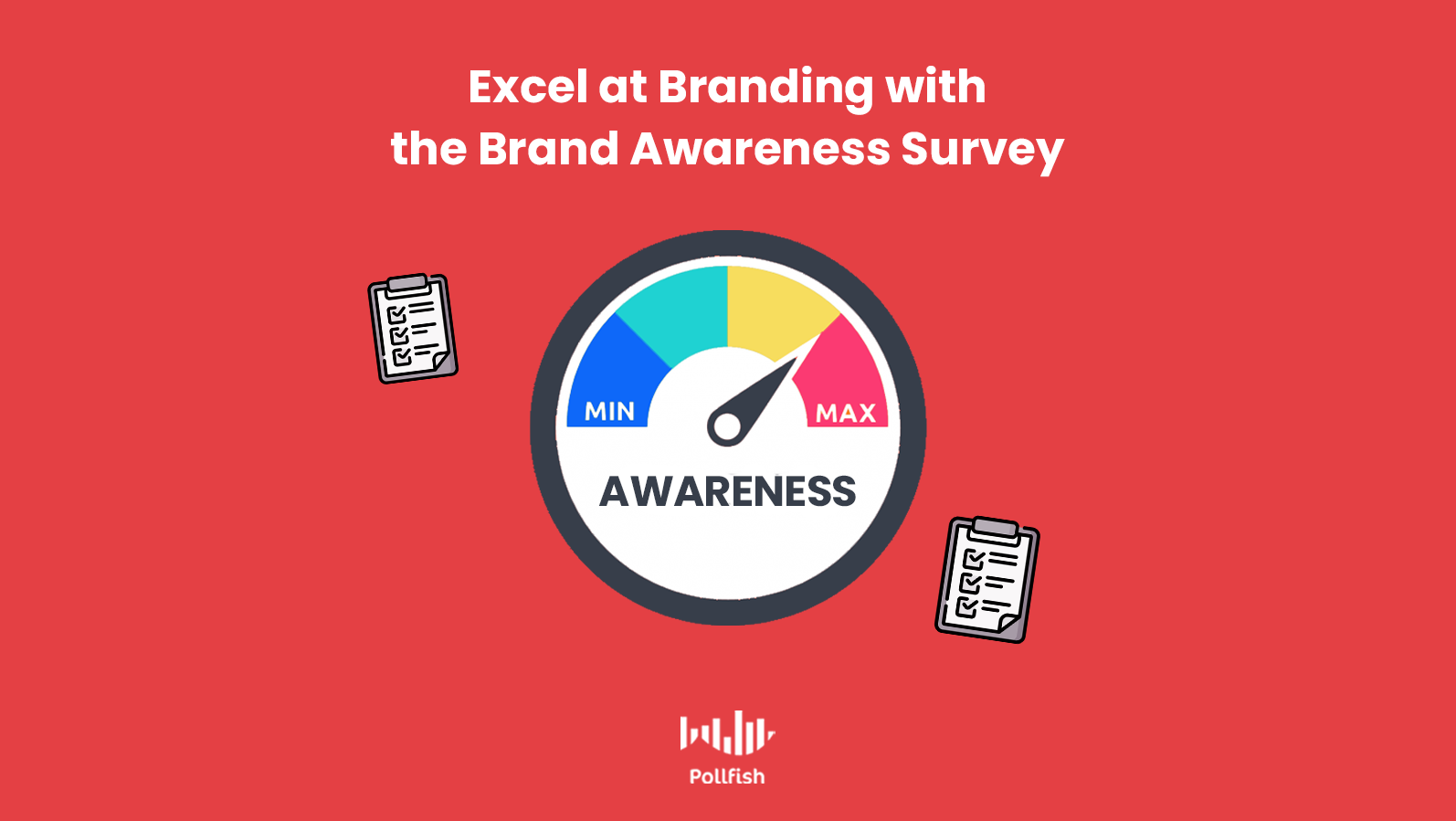
The brand awareness survey is an essential tool to gauge how well members of your target market and others recognize your brand.
It is often a starting point in the practice of branding, a key marketing concept that involves shaping how the public views your brand and what they associate it with.
Brand awareness initiatives are immensely important, as building brand awareness across platforms can raise revenue by 23%. However, consumers won’t immediately remember a brand; it takes consumers 5-7 impressions to remember a brand.
This article explains the brand awareness survey, its utility in the major types of brand awareness, along with how to create one and its overall role in branding market research.
Defining Brand Awareness
Brand awareness is the extent to which a brand is recognized by consumers in its target market and is associated correctly with its offerings.
Brand awareness cannot be measured with a single metric; rather it deals with two major concepts (see the section on types) that can be assessed in several ways.
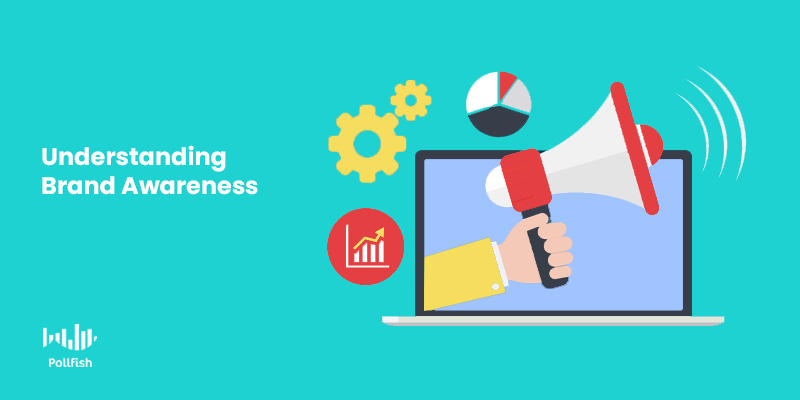
Brand awareness deals with product/ service recognition with the correct brand in numerous scenarios. For example, one of the concerns marketers face is the question of whether their brand is the first that comes to the minds of consumers when they need to buy something.
If yes, then such a brand has a strong brand awareness. This ties into the idea of visibility; when consumers are keenly aware of brands and constantly have them on their mind. Brand awareness campaigns help foster visibility via various presentation efforts. A consistent brand awareness increases revenue by 33% through presentation.
Defining the Brand Awareness Survey
A brand awareness survey is one of the most potent tools marketers can use to get a sense of their brand awareness. Since brand awareness cannot be clearly defined by individual metrics, this kind of survey is especially useful, as it crunches the numbers on the magnitude of a business’s brand awareness.
This is because the kind of tool is largely a quantitative survey, given that it measures awareness through yes or no questions, along with multiple-selection and single-selection multiple-choice questions.
The function of this kind of survey is to quantify a variety of awareness-related factors, including:
- who knows about your brand
- particular segments of your target market, which you can use for market segmentation
- what they know about your brand
- how much they know
- how they have heard about you
- what your brand is associated with
- This is especially important for brand-building as it makes consumers replace common nouns with a particular brand. Ex: Google for searches, Poland Spring for water.
Unlike other brand awareness measurement tools and methods, surveys have the unique edge of capturing demographic the information of participants. With this data on hand, you’ll understand which segments of your target market your brand resonates with the most.
Additionally, you’ll have a more comprehensive analysis of how well your customer base knows your brand and how you can improve your positioning in your niche.
The Importance of the Brand Awareness
Brand awareness is important on several fronts. Firstly, when someone is aware of your brand, they are already set within your sales funnel — at the earliest stage — but at the sales funnel nonetheless.
This means that when you’ve garnered a healthy brand awareness, many customers in your target market have already begun their buying journey.
Brand awareness is a must to push potential customers further down the funnel to reach the coveted purchase stage. Before customers convert, the various other stages fuel their decision-making. Without brand awareness, it is impossible to drive interest, evaluation and intent to buy.
The following explains the other key points of the importance of building brand awareness:
- It enables your brand to be recognizable under different circumstances and conditions.
- It creates associations between your brand and everyday matters such as:
- Actions
- Products
- Things
- It allows you to target different segments accordingly when you know their brand awareness levels.
- It lets you prioritize your marketing and market research needs.
- It informs you how to allocate marketing resources and funds based on the level of awareness among different groups.
- It is responsible for keeping your brand on top of your target market’s minds.
- It drives performance-marketing goals, including leads and sales.
- Ex: Boxed.com, an ecommerce site, increased its brand awareness through an earned media partnership, which raised its conversion rate by 3.18%.

The Two Types of Brand Awareness
Brand awareness occurs in two main forms: brand recognition and brand recall. It is crucial to understand both, as being able to do so will allow you to build effective survey studies for brand awareness.
This is because these two concepts are the chief makeup of brand awareness and in order to tackle this campaign effectively, it is crucial to be able to understand the two categories. In addition, the categories allow you to better organize your efforts.
Brand Recognition (Aided Research)
This refers to the ability of customers to recognize your brand when they also view others, including your competitors.
The brand recognition aspect of awareness is crucial when customers are presented with a variety of product choices at once, for example, when they are at a store or at an online marketplace that sells the same products from various brands.
In this instance, it is ideal for your brand to have a “top of mind” selection status. Customers are more likely to buy a brand they already know, unless they’ve had a terrible experience with it. When customers have a level of familiarity with your brand, they will be more inclined to purchase from it when presented with the same or even similar products from other brands.
Newer companies who have not established their brand in their markets ought to focus their brand awareness efforts on brand recognition, as people are generally more comfortable with choosing something they already know, rather than opting for uncharted territory.
Brand Recall (Unaided Research)
Brand recall refers to the studies that measure the ability of customers to bring the name of your brand to mind without seeing it on a list first.
When it comes to brand awareness surveys, this means you need to use open-ended questions, particularly those with the “other” option. For example, let’s say you ask if the respondent knows any of the brands in a list, thereby using a multiple-selection question.
If your brand has high brand recall levels, the respondents will choose “other” and type in the name of your brand in the open-ended field.
This method grants you higher quality data in that these kinds of questions have a higher “hurdle” than do aided research questions. This is also because an unaided study yields higher consumer preference than an aided study.
How to Create a Brand Awareness Survey
In order to create a brand awareness survey, you ought to first narrow down your needs. To do so, consider this: do you need to measure brand awareness to gain a general sense of your brand awareness, or to measure it in conjunction with another campaign (ex: advertising).
If you need to measure brand awareness in the general sense: choose whether to begin with a brand recall or brand recognition survey. Or, merge both into one survey. This will differ from brand to brand; as aforesaid, newer brands may want to invest in brand recognition studies.
Incorporate the following questions into a brand recall survey:
- When you think about [insert industry/niche], which brands come to mind first?
- List up to 5 open-ended field questions
- When you think of [product], what brand or brands come to your mind?
- Open-ended question field
- Which brands do you know the most about/
- List up to 5 open-ended field questions
- How open would you be to trying new brands in [industry/niche/product category]?
- Use a Matrix scale or scaled multiple choice answers
- Name your 5 go-to brands for [product/service/industry category].
- List up to 5 open-ended field questions
Incorporate the following questions into a brand recognition survey:
- Which of the following brands of [product/service type] have you heard of?
- The answers should be names of such brands listed in either a single-selection answer or multiple-selection answer.
- Have you heard of [brand name]?
- How familiar are you with [brand name]?
- When was the first time you heard about [brand name]?
- Multiple-choice, with an open-ended “other” option
- Where have you seen/ heard about [brand] recently? (Select all that apply)
- Multiple-selection answers
If you need to measure brand awareness with another marketing or market research campaign: choose whether to begin with a survey on your campaign separately from a brand awareness survey, in conjunction with one or to merge the two concepts into one survey.
Then choose whether you need to measure brand recognition or brand recall. Use the above questions together, or in separate surveys for your joint survey study. Make sure to ask questions that deal with specific actions you’ve taken in your other campaign to see how they have contributed to your brand awareness levels.
Brand Awareness Questions for Joint Campaigns:
- Have you seen this ad? (Include media file with the ad)
- Yes or no
- Does this ad make you want to buy from [brand]?
- Scaled answers (Ex: I’m not sure, I’d like to learn more)
- Does this brand remind you of any others? (for competitive analysis)
- Yes or no
- List up to 5 open-ended field questions if yes
- Does this quote remind you of any brands?
- Yes or no
- List up to 5 open-ended field questions if yes
- If this commercial didn’t convince you, what may strike your interest/memories with this brand?
- Open-ended field
The Need for the Brand Awareness Survey in Branding
It’s important to invest in brand awareness, as it associates actions and products with specific brands. This incites members of your target market to replace common words with branded ones subconsciously.
In turn, the customers naturally search for particular brands when completing their shopping needs and buy from those brands. The brand awareness survey is a critical tool for helping brands reach this level of customer consciousness by measuring the degree of brand awareness.
Given that researchers can ask virtually any question, they can form a questionnaire that reaps insights on both brand recall and brand recognition, guiding the studies of both.
Furthermore, brands can run these surveys continually, from the inception of their business to implementing market research techniques, to running experimentations and surveys that deal with other key business aspects such as advertising and product testing. The most critical component of running these survey campaigns is a viable online survey platform. Such a platform should facilitate survey creation, launches and analyses, along with making it easy to screen respondents and create the relevant question types for measuring brand awareness.
How to Do Market Research for a Business Plan Successfully
How to Do Market Research for a Business Plan Successfully

The entrepreneurial-minded folks may long have wondered how to do market research for a business plan.
After all, a business plan lays out the foundation, purpose and expectations of a new business venture. Given that the risks of starting a new business are manifold, entrepreneurs must conduct market research.
20% of American businesses fail after only their first year of operation, a dismal reality that climbs to 30% after two years.
Newfound entrepreneurs and serial entrepreneurs alike should therefore carefully commit to and execute a business plan.
While market research applies to a wide breadth of applications that cover various business cycles and processes, including opening and operating a new business, it too can be used for producing a
This article expounds upon how to do market research for a business plan — and succeed in your venture.
Defining A Business Plan and Its Needs
Before you set out to formulate a business plan, it is vital to fully understand all that it entails. Usually created for startups, it is necessary for all businesses to implement.
A business plan is a written document that summarizes the main aspects of starting up and managing a business, making it the foundation for your business.
A business plan specifically details a business’s objectives, along with its financial, marketing and operational needs and a roadmap thereof.
It is created to guide a business through each stage in its establishment and management. As such, it allows business owners to lay out their needs and goals and track them as the business grows.
A business plan must be updated at regular intervals, as priorities and goals are subject to change. Additionally, when an established business moves in a different direction, it needs a new or completely updated business plan.
The Importance of a Business Plan
A business plan is an important document and not merely for the purpose of monitoring your business as it develops. This is because this document is also needed to obtain investment, especially in the early stages of the business, in which it does not have an evidential track record.
Thus, a business plan shows investors whether your business is on the right course and is worth investing their funds into. Lenders will require proof of a business plan when they deliberate the approval of a loan.
Here are several other reasons as to why creating and updating a business plan is important:
- Making important decisions. It allows you to answer difficult questions at the onset, before they emerge. Understanding these decisions helps you understand how they fit into your overall strategy.
- Addressing key issues to avoid future problems. These include pricing, competition evaluation, market demand, capital and team members.
- Proving the viability of your business. Planning your vision into a full-fledged business bridges the gap between an idea and reality. Market research is essential for this point, as it helps you find key insights on various aspects of your industry, including your competitors and customers.
- Communicating objectives with team members and all those involved. This is important for larger teams, particularly for assistance when you are too busy to relay information or guidance to your team members. This may also help investors or partners who cannot reach you, as it lays out objectives and criteria.
- Standardizing and carrying out key objectives. Placing your objectives, criteria and other needs gives them more weight and attention. If they aren’t in your business plan, thereby, in writing, they can easily fall by the wayside. A business plan helps avoid this, standardizing key objectives and benchmarks.
- Guiding consultants, freelancers and other workers. When employing freelancers and contractors, you can turn to specific sections of a business plan to guide these workers, to ensure they understand your vision, goal and other key business aspects.
- Obtaining financial support. Whether it is via borrowing from a bank, turning to venture capitalists or putting your business up for an acquisition, a business plan makes your business and its viability clear for these key financial players.
- Acclimating to market changes. Updating your business plan can help you during periods of critical change in your market. These changes include: changes in customer needs, new regulations, trends or updates in your industry.
Defining Market Research
Market Research is a wide-encompassing practice that involves gathering information to bolster knowledge about a business’s industry, niche and target market.
It involves the systematic process of amassing, analyzing and interpreting data and information around the state of a business’s industry and its key actors. The key actors entail a business’s target market, competitors and the movers and shakers within its industry.
As such, it involves gathering research around the niche, trends and industry as a whole.
This involves gathering secondary research, research that has already been conducted and made available, along with primary research, the kind that requires you to conduct yourself. These main types of research gathering involve various means, techniques and tools that researchers can use.
Market research largely deals with evaluating the viability of a new product or service, although this aspect is primarily referred to as customer development. By conducting market research, you can therefore gather information on virtually all areas of your business.
Why a Business Plan Needs Market Research
A potent document, one that properly lays out the 7 components of a business plan, from the executive summary, to the market analysis, to the strategy, financial plan and all other in-betweens, most use market research to develop it.
Market research provides the key data, information and nuances your business plan needs. Although a new business or business idea is born on intuition, a business plan must be backed up with data to prove its viability and positioning in its industry.
As such, market research must be performed in the early stages of the business plan, as it is the phase in which you learn all about your niche, its trends and the demands of your target market (including the makeup of your target market via market segmentation).
Only after analyzing all of your market research results, will you be able to populate the business plan within key areas such as market analysis, financial projections, strategy and implementation, marketing endeavors, pricing and location.
A business plan must be comprehensive, another way in which market research is of utmost importance, in that there are various methods and tools you can use to conduct it. By consolidating all of the different market research techniques, you are establishing an exhaustive business plan, the kind that leaves no key consideration out.

The following presents the key data and information of a business plan that market research can extract:
- Demand: Does your product/service have enough market potential to justify a new business?
- Pricing: How will you determine the pricing of your offerings?
- Target Market: Who makes up your target market? Do they have enough spending power to buy your product or service?
- Location: Does your business require opening a physical store or can it effectively reach its target market via ecommerce? Perhaps it needs both?
- Historic data on your product/ service: How have the products and services in your niche performed over time? How do they perform currently?
- Marketing and Market Entry: How will you form an explanation on how you’ll enter the market? How will you promote your products/services to solidify your entry?
- Labor Requirements: Do you have enough manpower to form a business? How many employees and contractors will your business require?
- Financial Plan: Do you have the financial means to cover all operations?
How to Conduct Market Research for a Business Plan
Since a business plan ought to include concrete information to pave the way for business success, it requires thorough market research. Given that market research encompasses so many modes and forms, it can be overwhelming and even intimidating to begin to conduct it for your business plan.
The following provides a step-by-step guide on how to do market research for a business plan, so you can craft your plan in an informed manner, equipped with critical market research.

- Set a preliminary budget. This will allow you to make well-informed expenditures on market research.
- First, search the secondary sources available; while some are free, there will be many that aren’t.
- Identify all that you’ll need to know about your market. Set objectives and start from a high level of needed information.
- Then, narrow it down to a specific niche, with suspected market segments.
- Focus your research via secondary sources on your market. Look at trade publications, new sites dedicated to your market, industry reports, local reports, statistics websites, blogs on the startups in your niche, including their stories of success and failure and other secondary resources.
- Prioritize the findings in Step 1.
- Conduct further secondary research on your priorities.
- Then, switch to primary research methods to zero in on your most critical research subjects.
- Get acquainted with your target market: You’ll need to know who makes up your target market first.
- You can achieve this by conducting secondary research on your target market.
- Use primary research to understand your target market on your own terms.
- Use an online survey, a focus group or a survey panel.
- Segment your target market further and start building personas from the shared characteristics they exhibit.
- Conduct product/service research via secondary and primary means.
- Be sure to find similar offerings available to identify your competitors.
- Survey your target market on their needs and feelings towards similar products/services, along with their aversions and desires for updates.
- Research the costs associated with operating your business in relation to the products, supplies, services and maintenance it will require.
- This will help you understand how to set up your prices as well.
- Research the costs of marketing and publicizing the launch of your business.
- Compare all costs and establish a preliminary business budget.
- Study your competitors further.
- Jot down their strengths and weaknesses.
- Compare your offering to theirs, does it fill any gaps or voids? Is it better price-wise?
- Analyze your research.
- Break this down from high to low levels of research. Ex: From the general industry to the exact niche, from a large target market, to specific segments, to specific personas.
- Adjust your budget, goals and plans.
- Filter your research into the seven components of a research plan. These include:
- The executive summary, company description, products and services, market analysis, strategy and implementation, organization and management, financial plan and projections.
- Read and refine your business plan.
- Assure that everything makes sense. If there are gaps in the information you have outlined, consider conducting more research.
- Highlight areas of opportunity, along with areas of risk.
- Edit your business plan as needed.
Empowering Your Market Research-Powered Business Plan
Market research is a wide-reaching practice that blends consumer behavior and economic trends to help you validate and improve a business idea. It can also help you change the course or style of an already established business.
Thus, it is not solely for startups. Market research can be difficult to conduct and manage, as there are so many business aspects you’ll need to consider to lower your risk of failure. Concurrently, there is so many kinds of market research you can stand to conduct.
Even with the steps listed above, navigating through the jungle of market research can be a laborious and difficult task. While you can’t control secondary resources, you can wield control of your primary research endeavors via an online survey platform.
This kind of market research tool allows you to take the reigns in every aspect: from asking the exact questions you seek answers to, to targeting a specific market segment, to deploying your surveys across the most-frequented websites and apps.
A potent survey platform will complete all of these crucial tasks, making primary research an easy task. The trick is to find an online survey platform that can handle all of these tasks, along with making it easy to analyze the data.
How to Do Away with Typos With the Edit Questionnaire Feature
How to Do Away with Typos With the Edit Questionnaire Feature
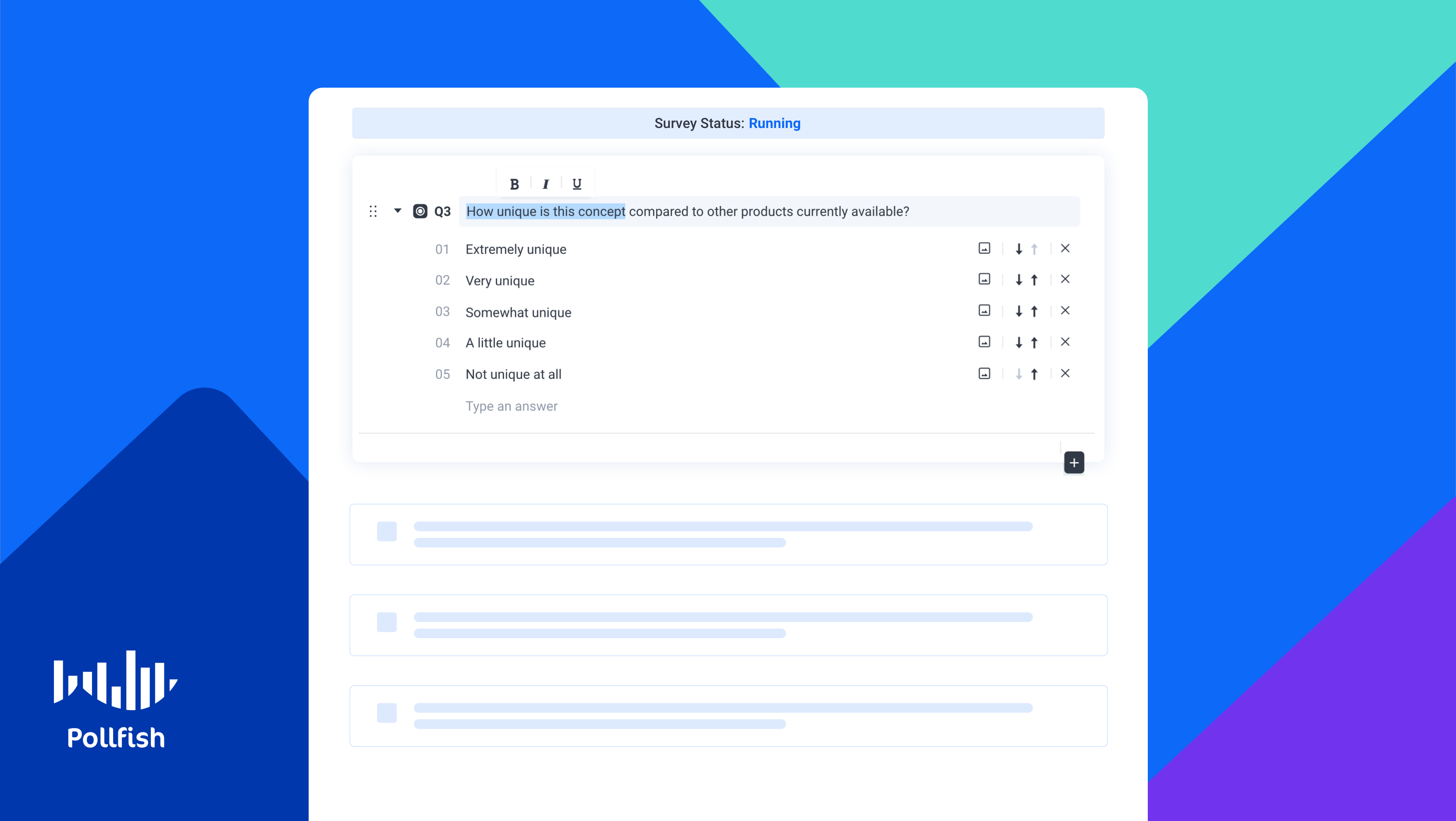
When forming the questionnaire — the heart of the survey — even the most diligent market researchers are bound to come upon errors. At Pollfish, we’ve created a solution that can nip this issue in the bud without needing to slow down the survey process.
Pollfish has released a new feature that allows researchers to quickly remove typos and correct any text-based errors in all surveys.
With the new Edit Questionnaire feature, researchers can edit their typos and other text if need be, in any survey they choose, regardless if the survey is still running or complete. This creates a much more smooth survey experience for the researchers, as they don’t have to stop a running survey, or even pause it to adjust textual errors.
This article explains how to use the Edit Questionnaire feature and how any market research campaign can benefit from it.
Understanding the Edit Questionnaire Feature
Market researchers have likely caught a typo error in a running survey in the results of a completed survey. Researchers now have the ability to correct typos and edit all text fields regardless of the survey status, thanks to the Pollfish Edit Questionnaire feature.
This includes making the corrections and other textual edits in questions, answers, statements, scale points, concepts, etc.)
This new feature is available to all researchers under all of our plans.
The Edit Questionnaire does not require researchers to make any status changes to the survey they are editing. As such, researchers don’t need to pause, stop or resume any survey they use this feature with.
The Usefulness of the Edit Questionnaire Feature
This feature is useful for virtually any survey research campaign, as it equips market researchers with a handy and practical way of fixing typos without halting or pausing a survey. Typos can occur even among the most meticulous researchers. It isn’t practical to stop a survey or change its status, as this delays the survey process.
The Edit Questionnaire feature is the solution to this pesky issue, as researchers can now fix typos within their running studies and share them with their peers. They can do so without stopping a running survey or duplicating it to launch a copy. They can edit any text while the platform is deploying surveys and extracting responses.
This is useful as it helps researchers make changes as soon as they find them, allowing them to edit their questions as they please.
How to Use the Edit Questionnaire Feature
In line with the Pollfish commitment to user-friendliness, this new feature offers ease of use and efficiency. The following explains how to use the Edit Questionnaire feature on the Pollfish platform.
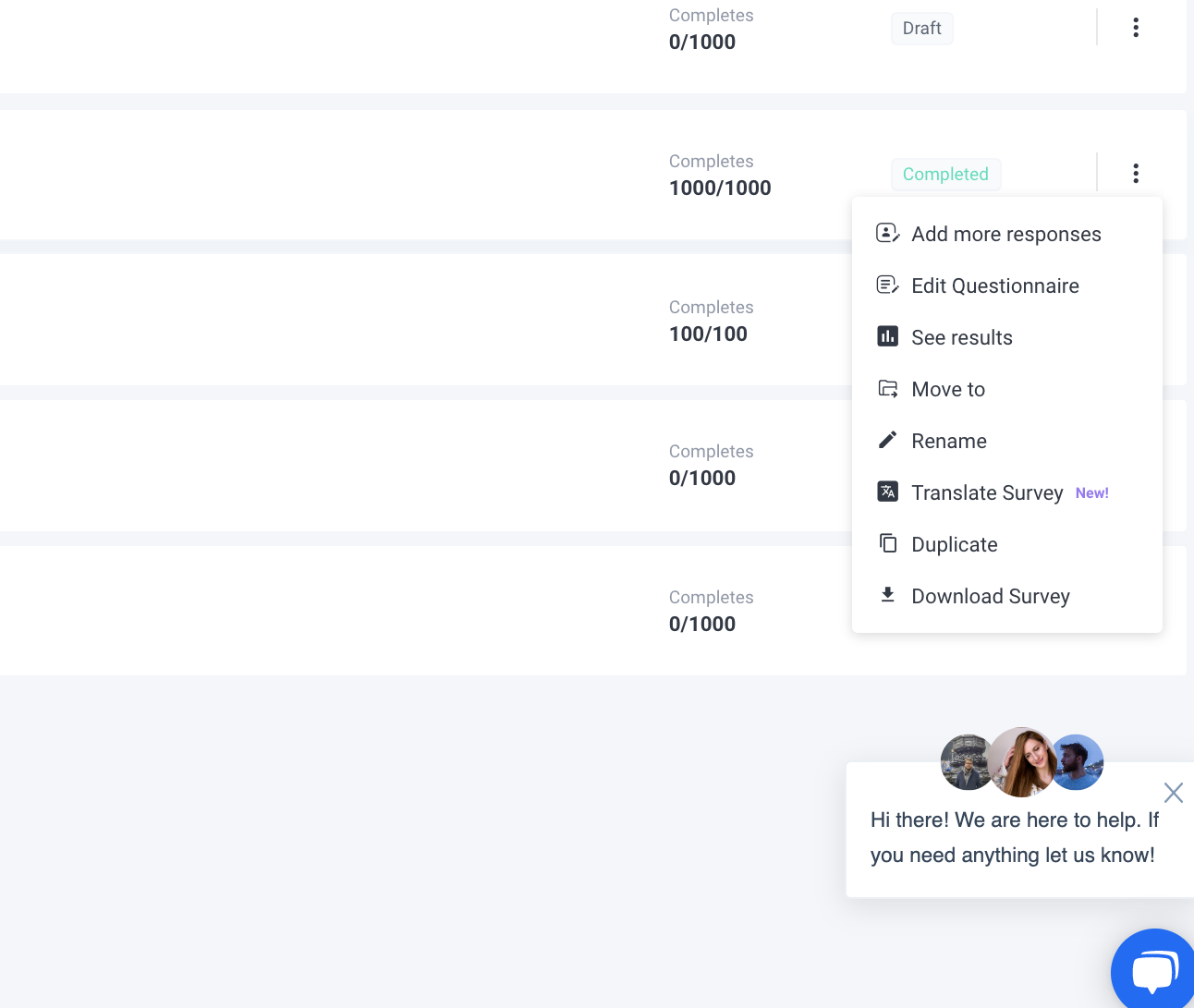
- On the Pollfish dashboard, go to the surveys and hover over the survey you would like to edit.
- Here, you’ll find the three-dot button that grants you options on changing the survey status and using a feature.
- Click on the three-dot button on the right of the survey you would like to edit.
- A dropdown menu will appear.
- Click on “Edit Questionnaire” and you will be taken to the questionnaire of the survey you clicked on, which you can then edit.
- The ‘’Audience’’ & ‘’Checkout’’ pages will be grayed out.
- Here, you can also apply changes to the ‘’recall information’’ option. The rest of the options at the left panel are grayed out (carry forward, skip logic, etc).
- However, you can review (only) the ‘’apply logic’’ rules per question.
- Select “save changes’’ in the questionnaire page to save any changes you made.
- After clicking on ‘’save changes’, these changes will be reflected on the results page.
- Please bear in mind that there is no ‘’auto-save’’ button.
- When the survey’s status is ‘’Under edit’’ (Edit Audience), the option ‘’Edit Questionnaire’’ is also available.
- If you want to discard your changes, click back and confirm the action.
Creating Quality Surveys
In summary, researchers can improve the quality of their surveys as their surveys are running. They can ward off both their own typos along with those of their respondents. After hitting “save,” the changes become instantly available to respondents and the results.
Thus, using this feature is effective and friction-free.
Remember, as our surveys are running, our online survey platform uses AI and machine learning along with random device engagement (RDE) sampling to ensure the highest quality of responses.
Machine learning performs quality checks that disqualify gibberish and other low-quality answers, those using a VPN. RDE sampling engages digital users across a wide net of digital properties, without pre-recruiting them to take a survey.
The Pollfish platform is, therefore, best equipped to extract and deliver the best results.
How to Lower Bounce Rate with Surveys
How to Lower Bounce Rate with Surveys
How to lower bounce rate is a common contemplation among marketers, market researchers and business owners. As one of the main issues across digital marketing, the omnipresent bounce rate is a constant concern.
While the average bounce rate sits at a range between 26% and 70%, an acceptable bounce rate range is far lower. Many brands struggle with lowering their bounce rate to a more acceptable industry range.
There are various digital marketing methods to lower the bounce rate; some pertain to specific industries, while others are more generalized. A seldom but potent way to reduce your bounce rates is by way of conducting effective survey studies.
This article delves into how to lower bounce rate with surveys, so that you can improve your website and apps’ digital performance. This will allow you to elongate digital journeys, the time spent on your site and the interest surrounding your content.
Understanding the Bounce Rate
Before tackling how to lower bounce rate, you should have a concrete understanding of what it is. Bounce rate is a negative metric, that is, it measures the rate of an action that marketers ought to mitigate.
Specifically, bounce rate is the percentage of website (or app) visitors who leave a website after viewing only one page. There are certain circumstances that constitute leaving a page: this can occur via closing a tab, closing a browser, hitting the back button, typing in another domain in the URL on clicking an external link.
This metric is undesirable on several accounts: first off, it reduces web traffic. It also reduces the time spent on a website, as browsing several pages often results in a longer time spent on a website.
But most importantly, the bounce rate is an unfavorable metric as it shows that your landing pages do not appeal to your visitors. First impressions are critical — even in the digital space. As such, a high bounce rate points to disinterest, boredom or lack of satisfaction with a page.
Perhaps your visitors didn’t find the information they were looking for, or perhaps they were routed to a landing page via social media and upon entry, they lost interest. As such, high bounce rates occur when landing pages (or any web pages) fail to engage.
Market research, particularly surveys can help the lower bounce rate.
Bounce Rate Calculation
The calculation for this rate is rather simple.
Divide the total number of one-page visits by the total number of website visits. Then multiple the quotient (the result of the division) by 100 to get the percentage.
For example: A website receives 50 single-page visits and 180 total website visits.
50/180 = 0.2777777
0.2777777 x 100 = 27.777 or 27.78%
Bounce rate = 27.78%
Although you can calculate the bounce rate whenever you need to, a good rule of thumb is to pay particular attention to it whenever you release new content. For example, say you created a new resource page or added new marketing collateral to an existing page.
In these instances, you ought to compute the bounce rate to understand their performance. You can also compare it to the more stagnant pages on your website.
What Makes a Good and Bad Bounce Rate
As an undesirable metric, your bounce rate ought to be kept on the lower end of the spectrum. Lower bounce rates indicate higher levels of website engagement, which is critical for a number of business purposes: from branding to building customer loyalty.
To control your bounce rate, you first must understand which range indicates a “bad” bounce rate, that is, one that's too high, which constitutes a “good” or healthy bounce rate and which is considered average. The following breaks up the bounce rate into three categories based on reports of average bounce rates.
| Exceptional | Average / Mid-Range | Poor | |
| Ideal bounce rates | 26 - 40% | 41 - 55% | 70% |
| Most bounce rates (lowest-highest) | 1%- 26% | 45 - 49% | 90.2% |
When this rate reaches 70 percent and above, you ought to strategize on how to lower it, as it represents a deficiency in both content quality and UX. A rate this high is going to trickle down to fewer conversions.
However, a high bounce rate is only dismaying for content aside from blogs, news, events, and anything that requires a significant amount of reading — which introduces a new aspect of bounces.
Are All Bounces Terrible?
This aspect points to the fact that not all bounces are bad. As such, it is essential to factor in the context of your bounce rate. Take the following scenarios:
If you have a high bounce rate on a product page, in which the visitor leaves without purchasing or signing up for, say, a newsletter, then it is evidently a bad thing. If your visitor were to visit several such pages, thus, avoiding a bounce and lowering your bounce rate, it is good, even if they don’t convert.
This is because avoiding a bounce in this scenario shows that the visitor is interested in browsing your products. In the former scenario, a bounce on a product page shows that they are not interested in exploring your other products or site, and bouncing to a competitor site is a major possibility.
As such, bounces on product pages, landing pages and all others that require taking an action (converting) is a bad incidence.
However, some pages with high bounce rates do not necessarily connote a bad sign. Consider content-heavy pages, especially those with no CTA for further action, such as downloading a report or signing up for email notifications.
For example, let’s say a visitor is consuming a long blog post, report, article or news content. They may then bounce. Regardless, the page they consumed was engaging enough for them to read through the whole thing, thus contributing to longer times spent on the site.
Additionally, after reading the content, the visitor may have deemed your content authoritative, fostering future site visits. Or, it may have nurtured a lead further down the sales funnel. This is far more valuable than a site visitor who travels across various site pages (thus avoiding bounces) without reading or paying attention to the content and elements.
Bounce Rates Benchmarks Across Industries
Bounce rates fluctuate from brand to brand and the same oscillation applies to different industries. This occurs from a number of different factors such as:
- The nature of the industry
- The average UX efforts and updates made on digital platforms across industries
- The content-heavy nature of industries
- Type of website
Bounce Rate Benchmarks by Website Type and Page Type:
The following presents data on benchmarks based on the type of website and webpage from Custom Media Labs.
| Type | Bounce Rate |
| E-commerce and retail websites | 20% – 45% |
| B2B websites | 25% – 55% |
| Lead generation websites | 30% – 55% |
| Non-ecommerce content websites | 35% – 60% |
| Landing pages | 60% – 90% for |
| Blogs, news sites, dictionaries, portals | 65% – 90% |
Bounce Rate Benchmarks by Industry:
The following presents data on benchmarks across different industries in late 2020 by a report from SimilarWeb and others.
| Type | Bounce Rate |
| E-commerce and retail websites | 35.8% |
| Financial Services | 28.3% |
| Publishers (Radio, TV, press via apps) | 51.3% |
| Cosmetics | 55.86% |
| Grocery | 40.2% |
How to Lower Bounce Rate with Surveys
You may have pondered how to lower the bounce rate through a practical route. While you cannot extinguish the bounce rate, you can lessen it by improving your website in a number of ways. Most marketing websites will provide you with advice on lowering your bounce rate in the following two ways:
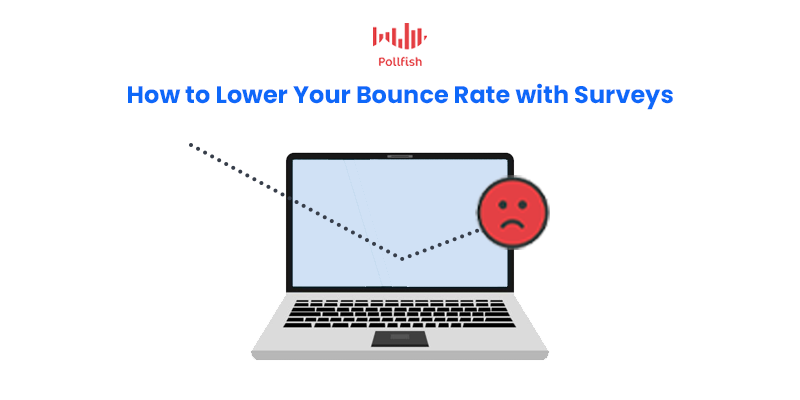
- Improving your user experience (UX)
- Fleshing out your content offerings
On the contrary and far less conventional, you ought to use surveys to reduce your bounce rate. Although slashing this rate may seem to be a feat, surveys help in that they find the disconnect between your visitors’ (and customers’) expectations from your webpages and what your webpages actually provide.
Businesses can use surveys to minimize the bounce rate for both B2C and B2B businesses. You can achieve the latter by implementing B2B surveys. If one of your biggest concerns around your bounce rate involves your content performance, you can deploy surveys for a content marketing strategy.
What to Ask in the Survey to Lower Bounce Rate
First off, you can ask respondents specifically what they look for in a particular landing page, product page, etc. In such a case, it is best to use multiple-selection multiple-choice questions, that is, questions that allow respondents to tick off more than just one answer.
This is especially useful if you deploy surveys across digital channels as part of an online survey platform. In this case, these surveys will be on websites (and apps) that are not yours, thus, you ought to ask for their specific needs.
You should also ask questions with visual elements (images, GIFs, etc) displaying your own digital elements. This way, respondents can see the makeup of your page and divulge their opinions of it. This question is especially viable when you use it to inquire about pages with the highest bounce rates.
Incorporating direct questions is another way to survey respondents to lower your bounce rate. For example, you can ask specifically what would make the respondents bounce. Piggybacking off of this concept, you ought to include questions that ask respondents to choose between a set of visuals, which represent pages or page elements.
They should choose the best and worst kinds from a set of images. You can also ask them to rate these pages/elements via a rating scale question or a Matrix question.
Setting Reasonable Expectations
The bounce rate is a metric you will often contend with. While bounces are not necessarily a grave issue on all site pages, certain pages, such as landing pages and product pages can do without high bounce rates.
Although known mainly as market research tools, surveys can provide the ultimate remedy on how to lower bounce rate. This is because surveys allow you to question your respondents on virtually anything, thus gaining you access into their psyche and needs from landing pages, etc.
When using survey research to crack down on your bounce rates, the key is finding the most apt online survey tool to house your surveys. Such as tool should make it easy to not merely set up and deploy your surveys, but make them hyper-targeted, so that only your target market and desired respondents can take part in it.
It should also automate quality checks to rein in survey bias and low-quality data. When you’re equipped with the correct online survey platform, you’re set to tackle lowering your bounce rates.
The 6 Main Types of Survey Questions to Power Multiple Applications
The 6 Main Types of Survey Questions to Power Multiple Applications
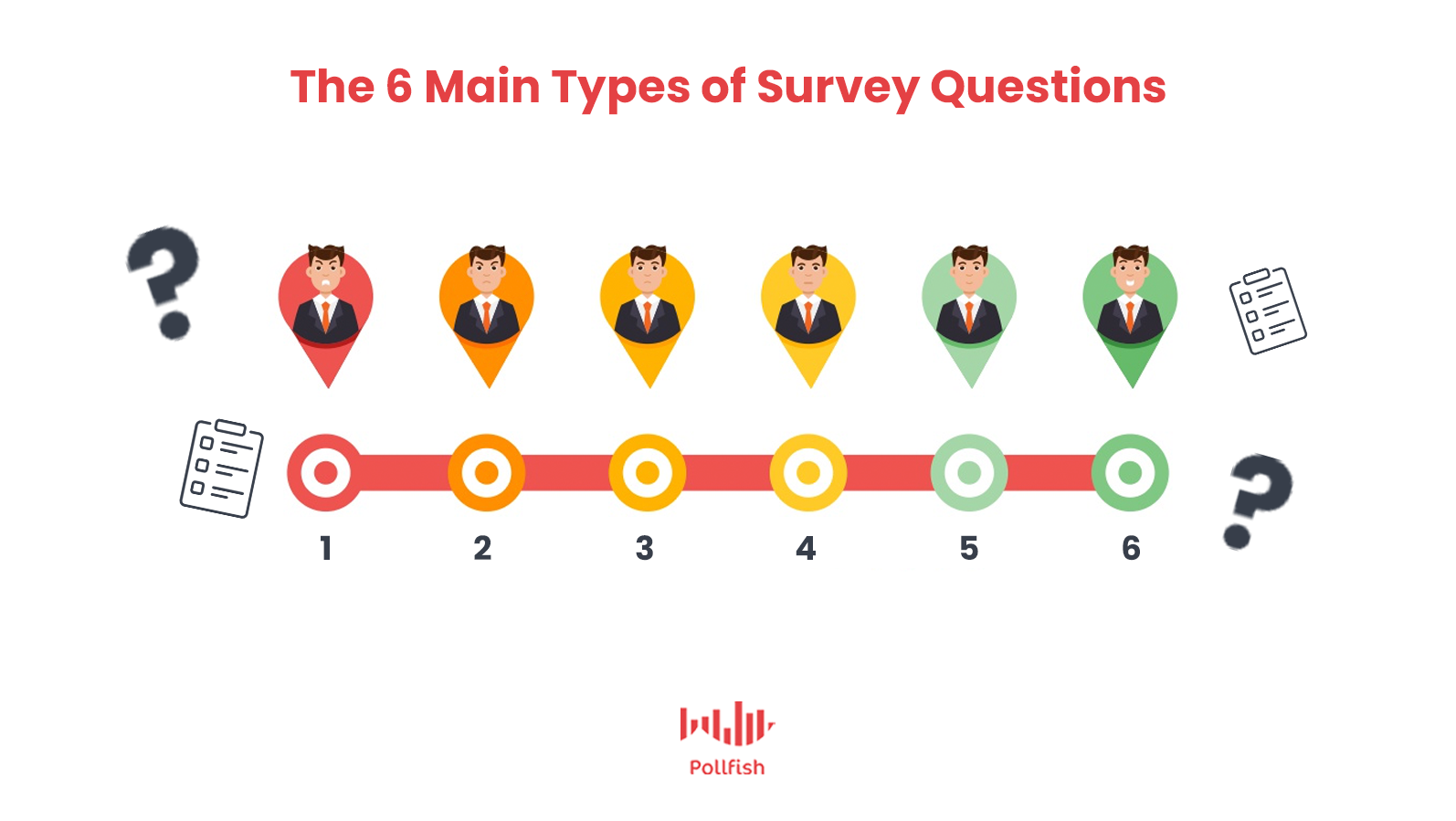 Survey questions are the core of any questionnaire and survey at large. It is the questions that drive the extraction of key data, insights and other information about your target market (for market research) or target population (for general research).
Survey questions are the core of any questionnaire and survey at large. It is the questions that drive the extraction of key data, insights and other information about your target market (for market research) or target population (for general research).
There are a wide variety of survey questions to implement into your survey campaign, whether it is for market research or other forms of research. There are also many ways to categorize questions.
This article expounds on the 7 main types of survey questions, namely market research questions, including examples and fitting applications, so that you can produce effective survey studies for your research campaign.
Close-Ended Questions
These questions are one of the most chief types of survey questions. They serve as the parent category in virtually every question type you’ll come upon in this guide and all others — except for open-ended questions, their antithesis.
Close-ended questions refer to any question that can be answered by selecting from a limited amount of answer options. These options can exist in various forms; these forms are the basis of the various offshoots, subtypes or child categories of close-ended questions (listed in the sections following the next).
Usually, these exist as multiple-choice questions, in which a respondent can select one answer, or choose several, i.e., all that apply to a situation.
Close-ended questions can draw simple, one-word answers, such as yes or no, or full sentence answers.
Additionally, these questions can be presented in a rating scale, such as “Are you satisfied with your experience with our company?" To which, the responses would exist in a scale: Very much so, mostly, yes, not sure, not really, no, not at all.
Close-ended questions are used to conduct quantitative research, in which data is collected to form statistics and discover patterns.
Although they give limited information, they are useful for several applications in the business world and virtually all others. They should be used when searching for trends and quantifiable behaviors and making generalizations.
Additionally, they provide quick insights into both general and specific topics, including important issues, such as that of trust:
“Do you find our website trustworthy to gather [niche] information?” This can be answered via a simple yes, no or not sure or as a rating scale question, e.g., from “not at all” to “very much so.”
Here are some of the most fitting surveys and applications for close-ended questions:
- Quantitative surveys
- Consumer surveys
- Cross-sectional surveys
- The NPS Survey and all other customer satisfaction surveys such as the CSAT and CES surveys
- Brand awareness surveys
- All customer experience (CX) surveys
- Business surveys
Examples of Close-Ended Questions:
- Did you find what you were looking for on our website?
- Which products do you look for/enjoy using the most? (Check all that apply).
- What times of the year do you usually plan a trip? [Multiple choice, multiple selection]
- Would you recommend our product/service?
- Which locations would you go to?
- What aspects of your life do you find most stressful?
- What kinds of services do you seek to help you through a difficult time?
Open-Ended Questions
The opposite of close-ended questions, these types of questions cannot be answered via a simple yes or no answer, nor can they be answered with single or multiple-selection multiple choice answers.
Rather, they allow the respondents full control over their responses. As such, open-ended answers can be short, consisting of a few words, to a sentence, to a paraph and beyond.
As their name suggests, the responses for these kinds of questions are limitless, save for the character count. These questions are used to extract in-depth responses to better probe into a topic. Additionally, open-ended questions can be used as follow-up questions to close-ended answers.
For example, if you asked the close-ended question: Which of the following brands do you feel is this best for your needs?
You can follow this up with an open-ended question that asks respondents to explain why they chose their answer.
Open-ended questions provide feedback in the customers’ own words, rather than with fill-in options that have been preselected. Open-ended questions form the core of qualitative research.
They help you draw more context around actions, opinions and explore the reasoning behind satisfaction and dissatisfaction with their customer experience (CX).
Here are some of the most fitting surveys and applications for open-ended questions:
- Qualitative surveys
- Retrospective surveys: they require these questions to express and compare feelings and opinions of the present with the past.
- Exploratory research: qualitative in nature, used in order to form hypotheses, define goals etc.
- Consumer surveys
- Employee feedback surveys, job satisfaction surveys
- Event evaluation surveys
- Prospective research
Examples of Open-Ended Questions:
- What was it like living in this neighborhood in New York?
- Please describe a time where you found our digital marketplace helped you make essential purchases.
- Why did you select [the previous question’s choice]?
- How do you typically deal with stressful situations?
- What would make you use our product/service again?
- Why do you choose this particular product over the others?
- Is there anything else we can do to improve your experience with our company?
Rating Scale Questions
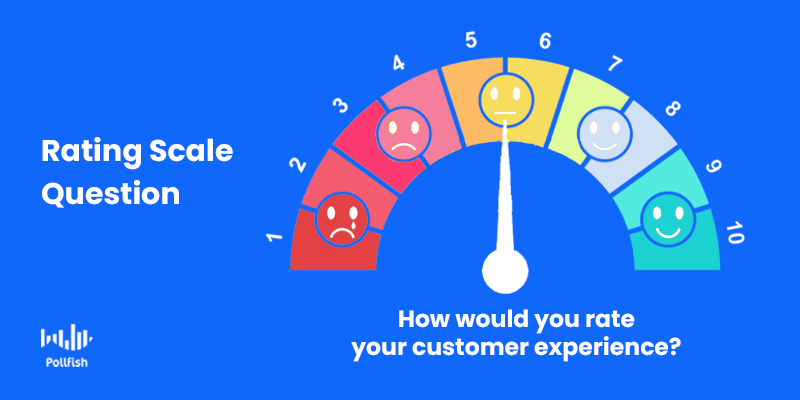
Also referred to as ordinal questions, these questions use a scale of answer options, as opposed to answers with words and sentences that denote separate objects and concerns.
As its name suggests, a rating scale question asks respondents to rate a sentence from a scale that uses numbers, emoticons, emojis or words. The words of the scale usually denote levels of either low to high intensity or go from negativity to positivity.
Respondents choose the number, word or emoji that best represents their answer.
Rating scale questions can be used for a number of applications. They are essential for questions that require far more nuance and precision than a yes or no answer. They are also ideal for a market researcher to understand their customers' exact feelings, attitudes and beliefs towards a number of business inquiries.
WIth rating scale questions, market researchers can further segment their target market by way of their opinions, which allows them to tinker their products, services or experiences more precisely.
Here are some of the most fitting surveys and applications for rating scale questions:
- NPS (Net Promoter Score) surveys
- CSAT (Customer Satisfaction Score) surveys
- CET (Customer Effort Score) surveys
- Likert Scale surveys
- Visual ratings surveys (ones that use hearts, stars, emojis or other visual ratings as scaled questions).
Examples of Rating Scale Questions:
- How likely are you to recommend this company to a colleague or friend, on a scale of 1-10? (NPS)
- Rate the following statement. Using the site navigation was extremely easy to do. (CES, a scale of extremely disagree to extremely agree).
- Overall, how satisfied are you with our company? (CSAT, a scale of extremely dissatisfied to extremely satisfied).
- The number of items in your online store overwhelms me. (Likert Scale, a scale of 7 options, strongly disagree to strongly agree).
- How would you rate your experience with our tech specialist? (Visual ratings scale, answers can use any emoji)
Matrix Questions
A Matrix question is a kind of close-ended question that asks respondents to provide an answer to one or more row questions using the same set of column answer choices. In this way, researchers do not have to create different answer types for each Matrix question, as each one can be answered in the same way.
It is similar to rating scale questions in that these questions ask respondents to rate or evaluate a number of services, occurrences of matters.
Like rating scale questions, each answer in a Matrix question carries a different amount of weight or intensity, from strong disagreements to strong agreements and other negative to positive responses.
The design of Matrix questions appears to be a chart, which makes it easy to identify and create.
Matrix questions are fundamental to use when your questions require nuance or you want to understand your customers’ precise sentiment in regard to your question.
While they can make it easy to interpret your customers’ answers, be wary when using them on mobile. Very long Matrices don’t fit mobile screens, which tend to be far greater in length than in width. They are not recommended for mobile.
Here are some of the most fitting surveys and applications for Matrix questions:
- Employee satisfaction surveys
- Descriptive research
- Customer loyalty surveys
- Evaluating advertisements and advertising campaigns
- Product satisfaction surveys
Examples of Matrix Questions:
- Rate the following: The customer support rep helped me resolve my issue. (Matrix from strongly agree to strongly disagree)
- How was your experience at our trade show? (Matrix from highly unenjoyable to highly enjoyable).
- How would you assess our webinar? (Matrix from very uninformative to very informative)
- How likely are you to make ongoing purchases from our online store? (Matrix from highly unlikely to highly likely).
- How many times will you make purchases from us in a year (Matrix from once to several times, such as more than five times).
Rank Order Questions
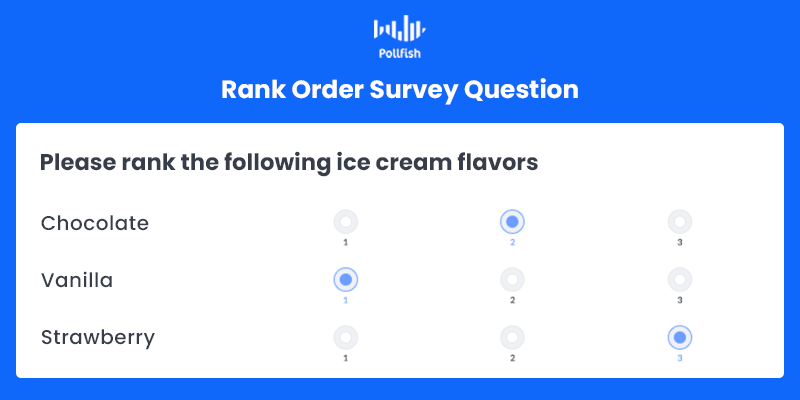
Also called Ranking questions, rank order questions ask respondents to compare items and rank them according to their liking. As such, respondents order the answer options by way of their preference.
It allows them to rearrange multiple choice answer options in the order of their choice, based on the opinions and attitudes they hold. Using rank order questions as opposed to other multiple-choice questions or rating scale questions is beneficial, as it lets researchers instantly understand their customers' preference of one item over another.
That is because the rankings are in each question, and unlike the Matrix scale, in which questions/ statements are on each row and answers are in each column, rank order questions feature the studied topics in each row and their ranking in each column. As such, a single question is set up in a Matrix-esque manner. As such, you the items and their ratings one after the other in one box.
This is also more convenient than other multiple-choice questions, in which respondents select multiple items without rating them or rating them but on an individual question basis.
Here are some of the most fitting surveys and applications for Rank Order questions:
- Product surveys
- All customer experience (CX) surveys
- Causal research and correlational research (in part but not in whole)
- Lowering the customer churn rate by understanding which products/ items need improvement
Examples of Rank Order Questions:
- Please rank the following pizza toppings. (Ranking depends on the number of items, ex if there are 4, rate them from 1-4).
- How would you rank the following seasonal fashion collections from worst to best?
- How was your experience with the following companies at the event? (Rate from I didn’t enjoy it to I highly enjoyed it).
- Rank the following accessories from our latest collection. (Ranking depends on the number of items).
Nominal Questions
Also called naming questions, or the categorical variable scale, nominal questions label variables into distinct categories. Unlike the various rating questions and rank order questions, nominal questions ask for answers with no quantitative value or weight of positivity, intensity, etc.
As such, these questions require no calculations of their answers, as each answer names a different category or type that has no quantitative relation to the other answer options. When numbers are assigned to nominal question answers, it is only for labeling or division.
The answers to nominal questions have no order; instead, they are meant to carry significance for variable labels only.
These kinds of questions are apt for initial research, such as exploratory, when researchers are trying to gather all the different variables present in their issue or situation.
They are also perfect to use when inquiring into the specifics of something, whether it is an occurrence, a preference or specific products, rather than rate them against one another.
Here are some of the most fitting surveys and applications for Nominal questions:
- Exploratory research
- Descriptive research
- Product satisfaction survey questions
- Cohort studies
- Advertising market research
Examples of Nominal Questions:
- Which brand of laptops from our store do you prefer? (Answers: Apple, Microsoft, Dell, Acer, Samsung, Asos)
- Where do you live?
- Which vacation destination do you want to visit the most?
- Which of the following ads have you seen?
- Which of the following ads would make you want to buy from us the most?
Making Every Question Count
While the 6 questions described in this guide are crucial for your market research endeavors, there are far more question types you can use to power your survey research. While this may sound daunting, the larger variety of question types helps keep your research quality high and fresh, giving you more types of data analysis to choose from and interpret.
Some questions you may come upon fall under one or more of the question types in this article, while others may be more unique. The most important thing to keep in mind is to not overwhelm your respondents with surveys and survey questions.
Keep your questionnaires relatively short and send your surveys to a random sampling pool. This will ensure that your respondents are not the same exact people every time — yet they still make up your target market/population. You can achieve this effortlessly with a strong online survey platform.
What is Correlational Research and How to Conduct it for Business Success
What is Correlational Research and How Do You Conduct it for Business Success

Correlational research is a critical form of research that researchers ought to deploy in the mid-late stages of the entire research process. It is especially necessary if it concerns a new topic.
Sequentially following descriptive research, which follows exploratory research, correlational research studies the relationship between two variables. This is important when attempting to make sense out of the variables discovered from exploratory and descriptive research.
Although correlation does not equal causation, understanding the correlation between two variables is crucial to see how similar such relationships may occur and how they behave within an existing occurrence, problem or phenomenon.
This article explains correlational research in-depth, including why it is important to conduct for business research, how to conduct it and more.
Defining Correlational Research
One of the chief forms of research, correlational research depicts and explains the relationship between two variables. This form of research is non-experimental, thus the researcher exerts little to no efforts to control or manipulate the variables.
The variables studied in this kind of research can be either quantitative or categorical.
Correlational research aims to find unknown or suspected relationships between variables, as this can point to similar behaviors or occurrences in other variables. If not, this kind of research is still powerful, as it paints a clearer picture of an issue or phenomenon that had been discovered in exploratory or descriptive research.
In correlational research, researchers measure the relationship between two variables, without controlling either one. The point of this kind of study is to discover:
- Positive correlation: Occurs when variables exhibit changes in the same way. Ex: As purchases increase, store traffic increases.
- Negative correlation: Describes variables that change in contrasting ways. Ex: Increase in employee burnout and a decrease in production.
- Zero correlation: When there is no relationship between the variables. Ex: Seeing employees in the office does not increase signed contracts with B2B partners.
The Key Aspects of Correlational Research
This form of research has several defining characteristics that researchers ought to consider. These aspects help identify this form of research, helping them use it for the future or to contrast it with causal or experimental research.
The following enumerates the key features of this research:
- As nonexperimental research, researchers do not need to manipulate variables to either agree or disagree with a hypothesis.
- It involves measuring and observing the relationship between the variables, with no external conditioning or alterations of any kind.
- It incorporates retrospective elements, as it looks back at past events and data of the variables, as a means to find and calculate historical patterns between them.
- It is conducted when there is some prior knowledge present from either exploratory or descriptive research so that at least one of the factors will relate to the predicted outcome.
- Although it may show a certain kind of correlation between variables, e.g. a positive one, it may not remain as such, as it can change in the future.
- Variables can be observed in a closed environment or via field research, i.e., a public space.
- It is used when the variables are too complex to be studied via the experimental method and controlled manipulation.
- It simultaneously measures variables and their relationships in realistic settings.
- It is executed when a relationship is suspected to be causal, but the researcher can’t manipulate the independent variable due to difficulty, impossibility or legal constraints.
- It is applied when one or a set of objectives requires gathering some degree of prediction.
Why Your Business Needs Correlational Research
Businesses benefit from conducting correlational research in a number of ways. Firstly, this research zeros in on previously murky or uncovered aspects from the entire research process, that of relationships between variables.
This research can confirm or refute these relationships, the hypothesis of their existence, along with the hypothesis of how they relate to the subject matter at large.
Secondly, when a business forms a clear understanding of the relationships between certain variables — whether they are good, bad or nonexistent, it is effectively equipped with the knowledge on how to move forward. For example, a correlational study may require further correlational research, causal research or experimental research.

Or, it may require fewer studies while presenting actionable insights on how to proceed with the studied variables and their environments.
Moreover, it helps researchers understand their studied variables in relation to the past, as it compares present behaviors and other attributes of the variables with retrospective ones. Piggybacking off of this concept, correlational research also helps businesses form predictions.
These predictions pertain to other similar variables, or the same variables and can have a bearing on the near and later futures. Correlational predictions are particularly useful for detecting patterns.
Example of Correlational Research for Business
While there are many different verticals in the sciences and scientific offshoots (ex: psychology, medicine) that appear to require this research, it may not often be so clear as to how it can help businesses.
However, as expounded on above, correlational research is crucial for business and market research. Here is an example of how a business used correlational research in their overall research campaign:
A business noticed the reduction of sales when conducting exploratory research. They noticed that in correlational research, there were particular items that were especially plunging in sales.
Thus, they performed correlational research and discovered that there are two variables that may have a correlation: the rise in kitchen appliances and the decrease in sales of those appliances.
Accordingly, the business deployed surveys to their target market and loyal customers to understand whether in fact, there was a negative correlation present. The surveys proved that this was indeed the case. With this knowledge in tow, the business offered a discount on the appliances, also having considered lowering the prices after some time.
Correlational Research Survey Examples
- The qualitative survey
- Helps understand variables in greater depth.
- Can explain variable behaviors in relation to their environment/context.
- The retrospective survey
- Delves into past events, occurrences and attitudes in regards to the variables.
- Shows whether the variables changed and how so.
- The prospective survey
- Can find associations between variables over a period of time.
- Useful for studying variables to form predictions and understand outcomes.
- The customer loyalty survey
- Great for comparing loyal customers against those who don’t buy from you but are in your target market.
- Measures the variable of continuous purchases.
- The employee satisfaction survey
- Measures relationships between employee satisfaction and workplace or company policy occurrences.
- Helps compare happy and dissatisfied employees.
How Correlational Research Differs from Causal, Exploratory and Experimental Research
Correlational research differs significantly from the other main types of research methods such as exploratory, descriptive and experimental research.
However, causal research is often conflated with causal research. While both kinds of research concern studying the relationships between variables and are conducted in the mid-late stages of research, they study very different aspects. As such, they follow different approaches and measure different things.
Whereas correlational research simply aims to understand how two variables relate to one another, causal research attempts to find a cause and effect relationship between two variables. This research type is more involved in making comparisons.
Exploratory research stands in complete contrast with correlational research, as it provides the very basis of a research problem and forms a hypothesis for later research, without involving variables.
Descriptive research delves into describing something already established, discovered or suspected in exploratory research. Therefore, it is composed after exploratory research in the overall process. It is still an early part of the entire research process.
Unlike correlational research, it attempts to describe what exploratory research had already established in greater detail, with new aspects emerging. It is not concerned with examining variables.
Experimental research contrasts with correlational research, in that it involves manipulating and controlling variables, whereas correlational research exerts absolutely no control or alterations to the studied variables.
As its name suggests, experimental research forms experiments on the variables as a means to discover cause-and-effect relationships. Using a scientific research design, this research involves a controlled environment, one in which the variables can be measured, calculated and then compared.
The Advantages and Disadvantages of Correlational Research
Correlational research offers several benefits for researchers and businesses. However, as with all other research methods, there are a few setbacks to this type of research.
The Advantages
- Allows researchers to determine the statistical relationship between two variables.
- An inexpensive and effective (not time-consuming) research method.
- Grants the research to understand a variable unaltered, existing in its natural state to fully understand it.
- Variables in their natural state are more applicable to everyday situations.
- Although it can’t prove causation, a large amount of collected and analyzed correlational data can support a causal hypothesis.
- Enables researchers to understand the duration and strength of the relationship.
- Using the correlation coefficient to measure a relationship’s strength (ranging from 1.00 to -1.00), the results are easy to classify.
- Provides the most ideal transition to conducting causal or experimental research.
- Provides insight into the way variables operate and exist with each other that other methods cannot find.
- Can occur through quick research such as via surveys or observations.
The Disadvantages
- It is limited, as it can only glean the statistical information from no more than two variables.
- Does not take cause and effect relationships into account, as it doesn’t find which of the 2 variables creates the statistical pattern.
- Does not show which variable wields the most influence.
- Cannot be fully depended on for further research, as it employs past statistical patterns to determine the relationship.
How to Conduct Correlational Research
A comparatively simple and quick way to conduct research, correlational research can be conducted using field research, i.e., via natural observations, through surveys and via secondary research. Here is how to execute this research using all of these techniques.
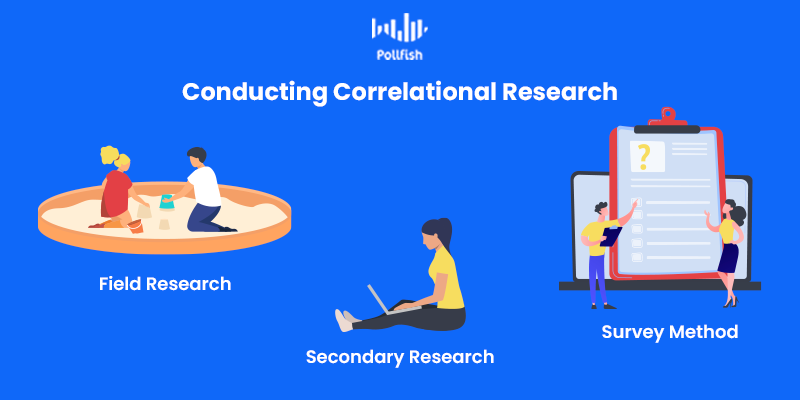
- Surveys: Allow researchers to get quick and easy to garner feedback (via an online survey platform).
- Ask questions about the variables. Use both open-ended and close-ended questions. The former is better for understanding the variables at a greater depth.
- Then, statistically analyze the answers.
- Field Research: Observe the variables in their natural environment.
- Study customers and passersby in physical shops, use a session replay tool in online shops.
- Record behaviors as they relate to the variables.
- Conduct secondary research: Find all the applicable literature and sources made available.
- These depend on your vertical and subject of study.
- Put them together and compare them to your own findings.
Mastering Correlational Research
Correlational research, although in the mid-stages of research, forms the very onset of relationship research into variables. Like descriptive research, correlational research describes variables, going a step further, as it tracks how one relates with the other.
It is essential to conduct this research to understand the kinds of relationships that exist between two variables before performing any testing on them, whether it’s for comparisons in causal research, or for experimentation in experimental research.
A strong online survey tool makes this possible and practical to carry out. As aforementioned, there are various surveys relevant to use for correlational research. An adept online survey provider will make it feasible to implement all forms in your research, along with sending them to their intended sampling pool.
Diving Into the Event Evaluation Survey to Excel in Event Marketing
Diving Into the Event Evaluation Survey to Excel in Event Marketing
Various businesses can benefit from an event evaluation survey, as many businesses implement event marketing.
Even if your business does not have an event marketing department or sub-department, you may still put together an event — whether it is for a cultural event with your team, a store’s grand opening, or a first foray into a marketing event.
This article delves into the event evaluation survey, its importance, how to create one, among other key aspects you ought to consider.
Defining the Event Evaluation Survey
Before delving into the definition of an event evaluation survey, it is critical to understand its premise: event evaluation. This simply refers to the actions performed to assess an event.
While there are many components of an event that require using tools other than a survey — such as attendee count, RSVPs, invitations sent, total expenditures, revenue or expected revenue from the event — the success of an event largely depends on its reception.
A survey can gauge this, which is specifically what an event evaluation survey does. As such, an event evaluation survey is a kind of survey designed to examine the opinions and attitudes of an event, usually deployed post-event to allow businesses and market researchers to measure its success.
Aside from discovering its success, this survey can unearth how attendees truly felt about it, which includes its shortfalls and inconveniences. In turn, this allows brands to create better events, including the kind that foster prospects into leads and nourish leads further down the sales funnel.
Why Your Business Needs an Event Evaluation Survey
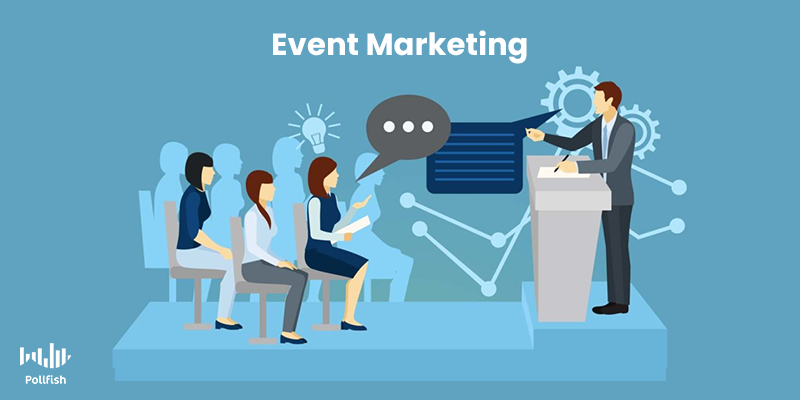
The event evaluation survey is not merely a tool used to extract the feelings of attendees after an event. Rather, it is a key aid to event strategy, the comprehensive practice of planning and executing an event.
Event strategy covers everything from concept development to planning the event, to working out the logistics and all else that involves setting it into motion. A well-produced event evaluation survey can derive insights into all of these event-centered nuances.
These insights will edify you on how to build productive future events, whether they are big or small and whether you’re the host or a guest. Additionally, an event evaluation survey can inquire attendees on matters not directly tied to an event itself — rather you can use it to ask about other key issues concerning your business that were in some way involved in the event.
For example, if you’ve attended a tradeshow, you can ask questions related to new business offerings that were highlighted somewhere in the event, such as at a booth, or brought up by a sales representative via word of mouth.
Or, you can ask questions about your customer service in relation to the event to leads and customers who have had some experience with your company.
Combining both of these facets — questions about the event itself and questions secondary to it regarding your business, form a valuable survey.
How to Create an Event Evaluation Survey
In order to create a fruitful event survey campaign, you’ll need to first evaluate the event yourself. Before coming up with the questionnaire, consider the kinds of high-level inquiries you have or will have after it concludes.
To understand these, consider the following:
- Who is expected to arrive at the event? Leads only or other segments of your target market? Or, perhaps customers in other niches similar to yours.
- Will people want to take your survey? This may depend on how long the event was and how involved were the participants.
- Do you need answers to better build future events or to push people further down the sales funnel? (Do you need attendees to be further nurtured, and if so, by how much?)
- Are you looking to see how much your attendees learned about your product or offering after the event? This can help inform your content marketing strategy and other marketing efforts.
- Do you need general information or more information for future events? This involves considering how events are run, especially if you are a visitor at an event and are considering creating your own company event.
Once you’ve narrowed down your needs to one of the above considerations (or more), you can start creating a theme around the survey on which your questions will be based.
Before composing the questions themselves, consider the types of survey questions you’ll need to use to power this kind of survey. After mulling over the kinds of available questions there are for creating this survey, you can start thinking up your questions in relation to the above topics.
Remember to keep your survey short, with a maximum of 7 questions, although 4-5 can suffice.
While there are numerous kinds of questions you can apply in your surveys, only a few are best suited towards an event evaluation survey.
Types of Questions to Use in an Event Evaluation Survey
The following presents the kinds of questions to implement into your event survey.

- Yes or No (Dichotomous)
- Some questions warrant a simple yes or no answer.
- These questions can follow up with an open-ended question so that your respondents expand on their answer.
- This is especially important if they answered “no.”
- Rating- Scale Questions:
- These questions offer scaled answers to show the intensity behind a feeling, thought or agreement with a statement. These include questions that constitute the concept of entire surveys, such as:
- NPS (Net Promoter Score) surveys
- CSAT (Customer Satisfaction Score) surveys
- CET (Customer Effort Score) surveys
- Likert Scale questions
- Visual ratings (ones that use hearts, stars, emojis or other visual ratings as scaled questions).
- These questions offer scaled answers to show the intensity behind a feeling, thought or agreement with a statement. These include questions that constitute the concept of entire surveys, such as:
- Multiple Choice:
- Can be scaled or nominal (answers with different names and categories and no scaled or numeric relationship)
- Can involve rated questions, aka, semantic differential questions
- Open-Ended Questions:
- These involve an open field for respondents to explain their multiple-choice or single-choice questions in greater detail and in their own words.
- Provide qualitative data.
Event Evaluation Questions Examples
Now that you understand how the questions in these surveys are classified, you can move on to composing the questions themselves. Make sure you use a variety of the above question types. This kind of diversity helps keep respondents more engaged with your survey.
Additionally, it gives you more varied means of uncovering key information on how your event has been received, how it can improve and how it’s excelling.
Here are some key question examples:
- On a scale of 1-7, how satisfied are you with this event?
- Type: Likert scale question
- Use: A general question such as this one grants you an understanding of the overall feel that attendees have of your event.
- This question gives you an idea of whether your event visitors were satisfied or not with your event. It also guides your survey into more specific questions.
- Was there anything in this event that you did not like?
- Type: Multiple choice question, can be followed by an open-ended question
- Use: This question is key to revealing how your event fell short and where it can stand to gain improvement.
- Use a multiple choice question if you expect certain categories to not perform their best, if you don’t have any in mind, present this as an open-ended question.
- How satisfied were you at this [specific point or interaction] in the event?
- Type: CSAT (Customer Satisfaction Score) question
- Use: This question brings a key moment in the event to light. Perhaps there was one particular speech, or moment in a speech you need specific feedback on. Or perhaps, there was an activity planned (which included a high expenditure) you need feedback on the most.
- What did you like the most about the event?
- Type: Multiple choice question, multiple selection question
- Use: This kind of question should include more than one answer, as such allow respondents to tick off several boxes. This will help you understand what you’re doing well in your event, to possibly repeat in the future.
- Add a follow-up open-ended question, or an “other” option with an open field.
- Do you have any suggestions for future events, including the time and date, the venue, speakers, sponsors, etc.?
- Type: Open-ended question
- Use: A very specific question, it also asks for suggestions, meaning things that previous questions shouldn’t have covered. As such, keep this as one of the final questions, if not the final one.
- This gets you to the bottom of exactly what the respondents are looking for in future events. Following their wishes will prompt greater attendance.
The Pros and Cons of an Event Evaluation Survey
Using this kind of survey has a wide swath of benefits, some of which you may have already grasped. However, there are even more advantages to using this survey. But with the good comes some undesirable qualities. The following lists both the benefits and setbacks of using an event survey.
The Pros
- Gaining valuable, specific insights about an event both in whole and in specific parts of it.
- Uses questions that give you insight into customer satisfaction and customer desires, allowing you to understand how to better cater to your target market in general.
- Provides insight on what can be improved and what is desired.
- Grants you insight into what to spend on in future events, helping you budget correctly.
- Show you how you compare with other business guests at an event (such as an expo or trade show) depending on the questions you use.
- Shows you what to avoid and thus what not to spend funds on in future events.
- Allows you to compare customer/attendee behavior with feedback, i.e., their true thoughts.
- Educates you on how to organize a future event and understand how to calculate its scale more fittingly.
The Cons
- Many event-goers may not want to take a survey.
- If a survey is administered during an event, attendees may rush through it, thus tainting the quality of data.
- Some responses may further explanation or questions, which not every survey provides.
- May not get useful answers from neutral respondents i.e., those who do not feel any particular way about your event, which won’t show you how to improve or what to continue doing in the future.
Excelling in Event Marketing and Beyond
An event evaluation survey is a crucial tool for making sense of your events and understanding how they are received. Usually, it is associated with event marketing, the discipline of marketing that promotes a company via live events (or virtual events, as is the current case).
However, this kind of survey can help you excel on so many other fronts in your business. As such, you can use it to better understand your own company-wide events, such as kick-offs, monthly, weekly or annual meetings or post-work cultural events.
This is particularly valuable for HR-related manners, such as company culture and employee satisfaction at large. After all, when keeping a pulse on your company, you need to assure your employees are happy as well (and fully aware of the company’s direction and their own responsibilities).In this way, the utility of the event evaluation survey highly extends beyond measuring the success of events alone. The key to reaping the most out of such a survey is with the correct survey tool. A strong online survey platform can help avoid some of the cons that were aforementioned.
New Pollfish Feature: A/B Testing Directly in Questions with the Monadic Version
New Pollfish Feature: A/B Testing Directly in Questions with the Monadic Version

Pollfish is thrilled to now offer an A/B testing functionality in our dashboard, enabling market researchers to easily test concepts alongside one another. It is now easier than ever to test a variety of concepts, whether it is for marketing, advertising, branding or pure market research needs.
A/B tests can be used to compare product concepts, communication ideas, or specific ads using equally structured groups of participants.
In our first iteration of A/B testing, we introduce the Monadic version. Two more versions are slated to be released on the platform — all of which are set up as a question type. The next two are the sequential and conjoint analysis.
The monadic and sequential version is open to all account types, while the conjoint analysis version is for Elite accounts only.
This article explains A/B testing, how to use it in the Pollfish platform and the three versions Pollfish offers.
Understanding A/B Testing on the Pollfish Platform
A/B testing on Pollfish is performed as a new kind of question type. That means, to perform the test, the A/B testing function has to be added to each survey that researchers wish to apply the test to. As such, A/B testing is an option that researchers can apply to their survey.
There can only be one A/B test per survey.
Researchers cannot apply advanced skip logic in the A/B group. However, they can apply logic to questions before and after the A/B group, as well as include the A/B group in the logic path.
All respondents who will be directed in the A/B testing will be randomly assigned to a concept, if the test is monadic. Pollfish ensures that all concepts are evenly distributed to the audience.
You cannot apply the question function of Recall Information, which places the text from a previous question onto another or the Carry Forward function, which pipes a part of a question or answer into another, to questions within the A/B Test. Those features are disabled in the A/B test.
There are different options available to view the A/B test results. Researchers can filter per concept; they can isolate a concept or compare two or more concepts.
Different table views are available for different questions, such as Single, NPS, Rating stars etc.
The researcher can view the concepts per answer or per concept. Attributes (more on this in the following section) will be displayed next to the questions.
The Monadic A/B Testing Version
Monadic testing is a useful survey design that allows a respondent to claim their preferences for one concept or product they will randomly get, out of the many that the researcher wants to test and compare, instead of being exposed to two or more at once.
Focusing participants' attention on just one stimulus at a time grants researchers a deep dive into making product, pricing and various marketing decisions.
Monadic testing is typically used for gathering independent findings for each stimulus — a contrast to comparison testing, where several stimuli are tested side-by-side.
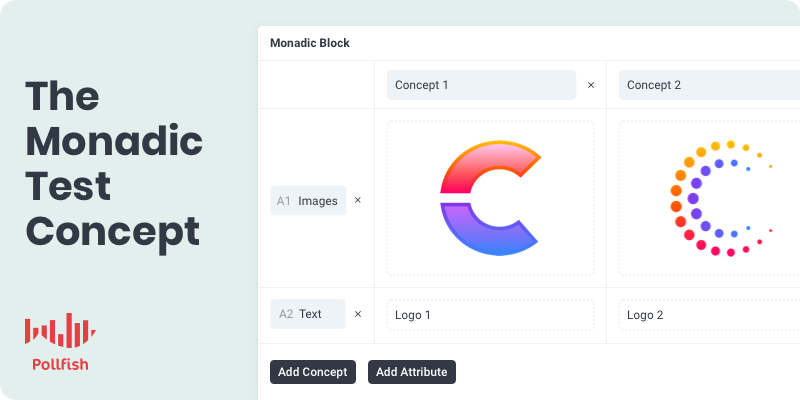
In the monadic version, each question in a monadic group counts individually to the cost calculation as a simple question. For example, if the monadic group includes ten questions and you add eight questions outside of the monadic test, the price will start at $1.25 per response in a basic account.
The monadic test uses what is known as “attributes" which allow researchers to use different representations of the concept in a monadic question. These involve different media, such as images, videos, GIFs, audio recordings, long descriptions, short text such as a tagline and use text formatting.
For example, for a soft drink concept testing, you would add logos, packaging, and pricing attributes.
The attributes in monadic testing are displayed on a monadic table, which defines the order of the attributes. The rows (in the left panel) are named A1 (the first), A2 (the second) and so on. Thus, the respondents view every question within the A/B test accompanied by the attributes selected at the left panel.
Researchers can apply logic and direct responses after the monadic test; thereby skipping it. In this case, the researcher must understand that the final results for each concept may not be evenly distributed. As aforesaid, skip logic is not supported within the A/B test, so it can only be applied outside of it.
How to Create a Monadic Version A/B Test
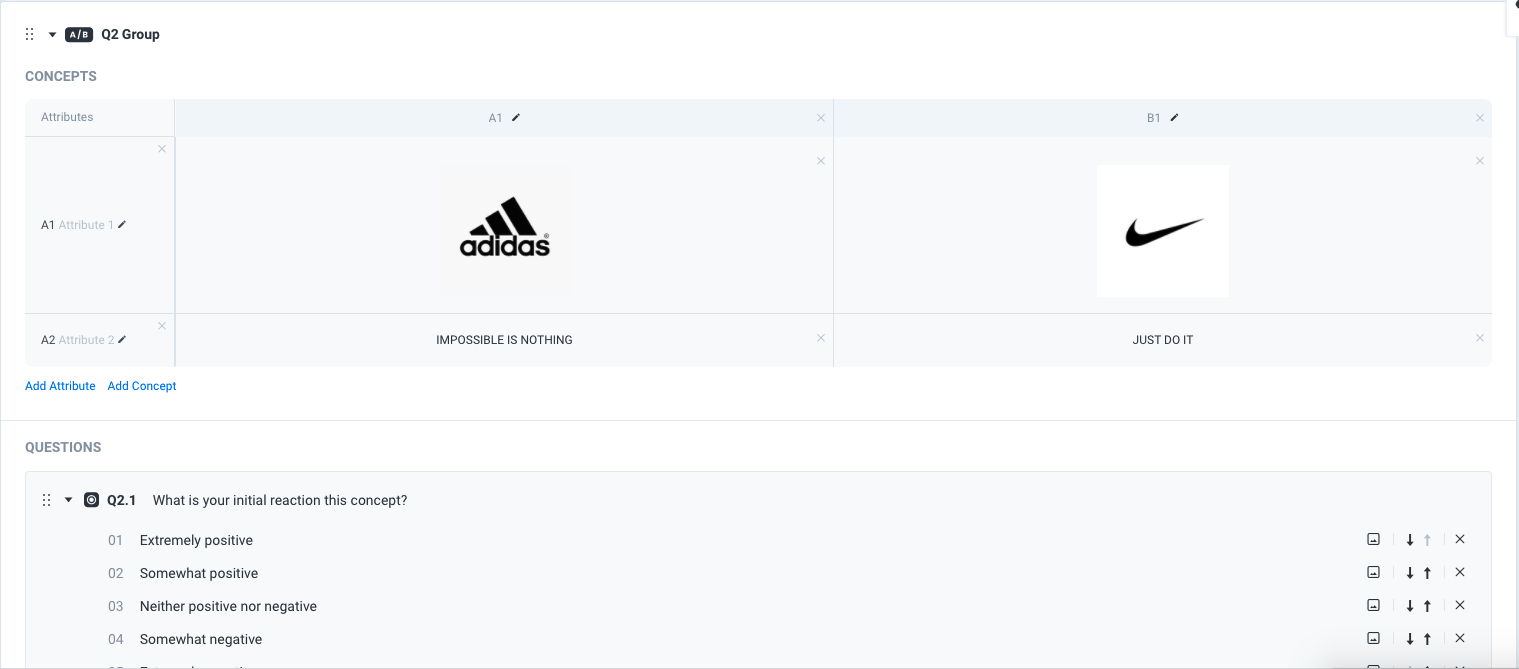
Follow these steps to create and view a monadic A/B test on the Pollfish platform.
- To create a monadic test, go to the questionnaire section of a survey.
- In the left panel, click on "add new," then click on AB Test.
- Below that, there is a dropdown menu to select the type of A/B test. Choose Monadic.
- In the concepts table, enter the attributes, these can be media files or text or even combined.
- You can view these in your results page, while the survey is running and when the results are ready.
- As the survey is running, you have the option of translating the survey, including the A/B group of questions.
Using A/B Testing to Accompany All Campaigns
With the recently released feature of A/B testing, Pollfish allows market researchers to test virtually any concept while running a survey in tandem.
With three new kinds of A/B testing soon to be available on the Pollfish online survey platform, it is now easier and smoother than ever for market researchers to incorporate A/B testing into their survey research.
Pollfish supports all exports (except the crosstab) for A/B tests. These are generated containing the concept data per each question. Hence, each question is generated as many times as the concepts, and is accompanied by the concept name to distinguish between the different concepts. Crosstab export with concept data, will be supported shortly after the monadic version is released.
Market Research Vs. User Research: Which Does Your Business Need?
Market Research Vs. User Research: Which Does Your Business Need?
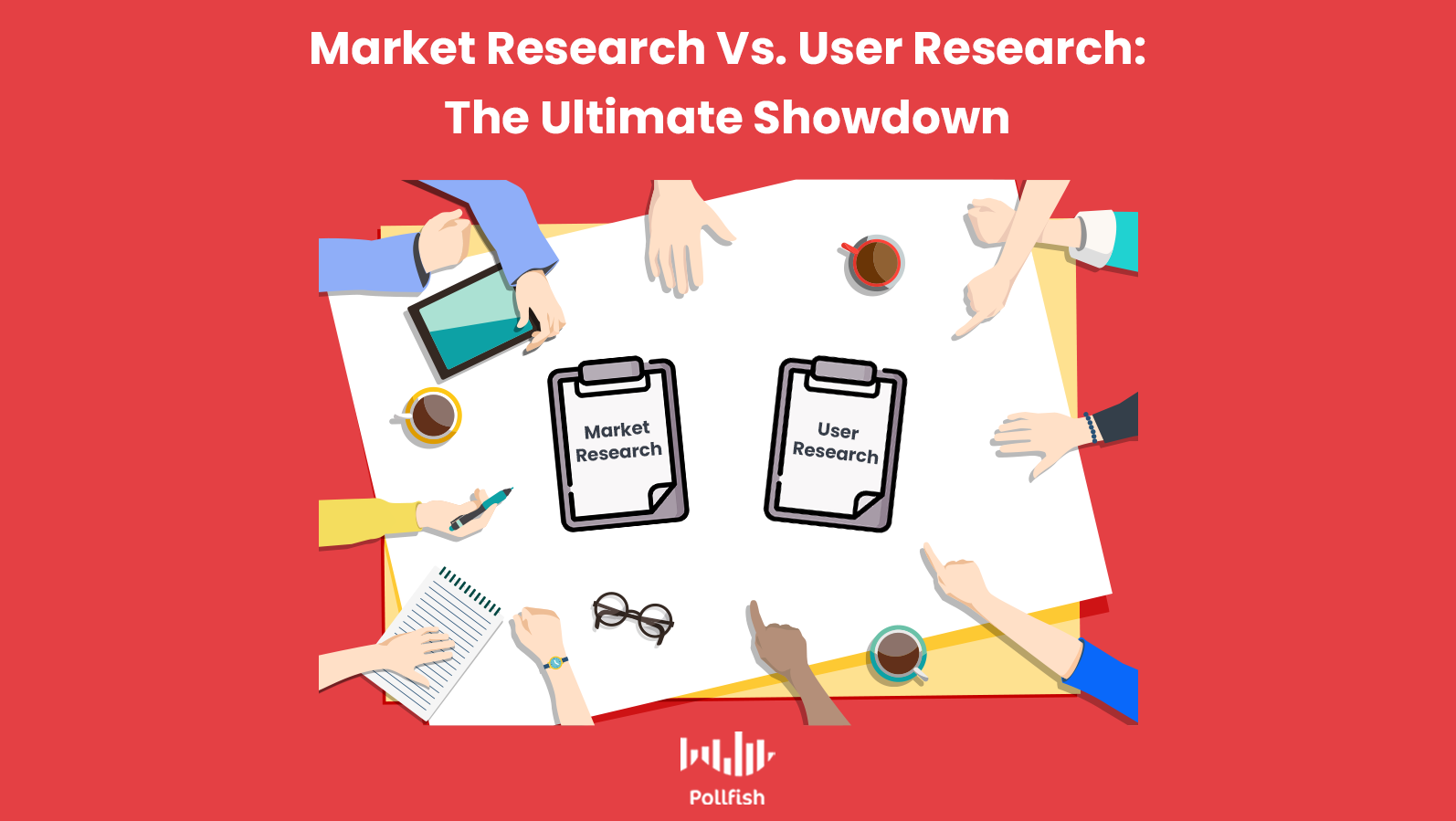
Market research vs. user research: which is more important? This is the question many businesses must contend with. One thing is for certain; a business needs to conduct research in order to identify viable opportunities, latent threats and customer sentiments and needs.
In today’s age of evolving digital technologies, customer needs have also become more demanding — 63% of consumers expect businesses to know their needs and expectations, while 61% of customers have switched to a competitor after a bad customer service experience.
Businesses must therefore be discerning on the research they decide to use, whether it comes from in-house or external providers. Usually, combining both kinds is necessary in order to conduct both primary and secondary research.
Market research and user research apply both; additionally, both of them can be used within the 6 main types of research.
This article provides insights when facing the market research vs. user research debate so that you can determine the aptest kind of research for your business.
Defining Market Research
Market research is a term that encompasses several processes and methods for extracting information about a market. Specifically, it denotes the practice of collecting, analyzing, interpreting and consolidating data on your customers and industry at large.
This includes gathering data and information on your competitors, target market and your own products, services and experiences. As such, it refers to a holistic approach to gathering research for your business, as it relates to your business and its overall niches and industry.
Conducting market research is essential for understanding your target market — the segment of customers most likely to buy from you. Additionally, it allows you to make continuous improvements to keep up with changes in customer opinions, attitudes, behaviors and demands.
Aside from enlightening your business on its CX, market research allows you to understand the inner workings of your entire field, from your direct competitors to those not within your niche, to innovations and much more.
The Importance of Conducting Market Research
Performing market research is crucial for businesses big and small, for the reasons stated above and several others. First off, market research entails gathering secondary data from virtually all sources that pertain to your business and its encompassing industry.
From checking your competitors’ digital properties to keeping tabs on their ads and social media, along with turning to trade publications, news, statistics and market research websites, it allows you to stay informed on all the ins and outs of your industry.
Then, there’s the customer side. Market research ensures a satisfying and friction-free customer experience by studying the concerns of your customers. This goes beyond studying secondary source trends and statistics.
Instead, primary research is a large component of the process. By conducting a consumer survey, interviews, focus groups, field research or running experimental research, you will gain a deep understanding of your customers. There are other methods of performing primary research, all of which fall under market research.
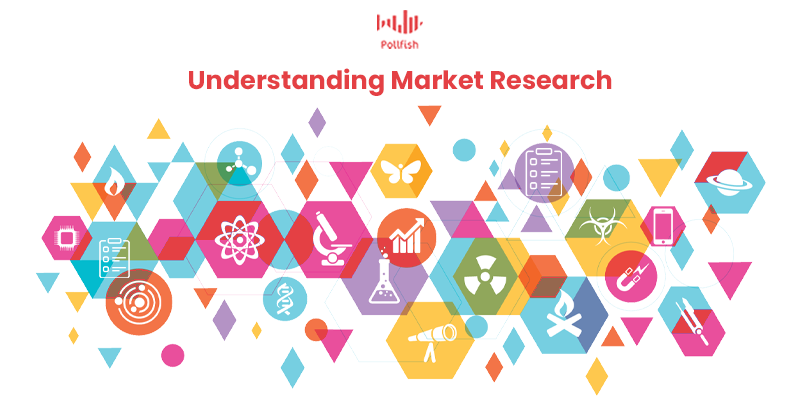
By studying your customers, you gain the imperative knowledge for catering to them, along with steering clear of their aversions. As such, you can avoid issues that tarnish your brand’s reputation along with those that trigger customers to patronize your competitors.
You can also run market research campaigns on your own products and services, to see how your target market truly feels about you. This practice can also help you discover what’s missing in your industry, allowing you to innovate more quickly.
Continuously running market research campaigns will thus guarantee you stay well-informed on all the concerns, needs and opportunities of your business and the overall market.
The Pros and Cons of Market Research
While invaluable for businesses who wish to not merely stay afloat but to become and remain competitive, market research also carries a few drawbacks. Businesses and researchers ought to be aware of both the benefits and pitfalls of market research.
The Pros
- Allows you to stay abreast of all changes, behaviors and innovations within your industry.
- Enables you to conduct market segmentation to discover the segments making up your target market.
- Grants you insight into all of your target markets’ needs, attitudes, aversions and sentiments.
- Helps you brainstorm and strategize more effectively, as you are equipped with data.
- Limits risks and liabilities.
- Propels higher sales.
- Measures viability of new products and services.
- Helps you find the gaps and limits in your industry, ideal for creating new products and offerings.
- Finds new markets and niches you can explore and eventually serve.
- Supports all decision-making processes.
The Cons
- The total sum of all the research that makes up market research can be expensive.
- It forms a long and winding process, which can make certain campaigns feel boundless.
- It requires keeping track of ongoing changes, as such, certain sources may not be as relevant and accurate of the industry.
- There are biases present in many sources of information:
- Primary research: survey bias, lack of field research to form conclusions, dishonest interviews, etc.
- Secondary research: biases in secondary publications, outdated content rebranded as new (via date changes but no updates)
Defining User Research
User research comprises far more than usability testing. Also called design research, user research aims to study the users at the center of the design process of your products and experiences. As such, it involves examining the various needs, concerns and pain points of your target users.
This kind of research is primarily useful for product designers and experienced producers, who use the insights from user research to make educated decisions for decisions. With this form of research, designers avoid or reduce product glitches, gaps and producing things with scant market demand.
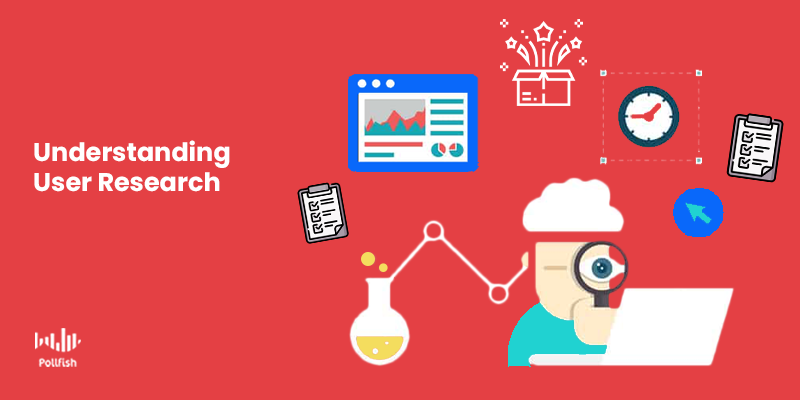
Like market research, it relies on a wide range of methods and processes in order to gain the information the designers and product managers seek. The various components that form user research can thus be used to discover design opportunities and crucial information to guide the design process.
User research involves conducting ethnographic studies via interviews or performing user testing, quantitative research on the ROI of your products and UX designs and surveying your target market. The latter involves a wide range of topics, such as existing product satisfaction surveys, surveys on your product ideas, surveys on competitor products and many more.
Other user research methods and tactics include:
- Accessibility evaluations to ensure an inclusive design of your product.
- Studying customer journey maps, essential to understanding your customer journeys, is a major aspect of digital CX (customer experience) or UX.
- Studying website analytics to understand traffic, bounce rates and other metrics to learn which content engages and which requires improvement.
- Evaluate information architecture via card sorting so that you assure your design is structured logically.
- Conducting contextual inquiries via field research (in-store observations, observing product testers) and digital observations (chats, a customer experience survey)
The Importance of Conducting User Research
User research is of the utmost importance when it comes to design strategy, as it functions as a foundation for it, along with a continuous source of insights to strengthen it. It equips project managers, designers, markets and business owners themselves with key data to buttress your design ideas and decisions.
This kind of research allows you to pinpoint the best candidates for using your product, as well as the members of your market segments who would be most likely to engage with a digital asset. In turn, this aids your marketing strategy, as you’ll understand which segments to target in your marketing efforts.
User research can foster this activity, as creating a successful marketing strategy relies on avoiding the mistake of marketing to everyone. As such, you cannot target all the segments of your target market in the same way. You’ll need to create different messaging for each segment, some of which require marketing entirely different products and experiences.
User research thus forms the bedrock of a productive marketing strategy.
Moreover, user research forms the basis of a product-design cycle. While you may be confident in a product idea, design, or upgrade, it is useless if no one else has a need for it or finds it difficult to use. Thus, user research assures that there is both demand and, as its name implies, usability, within your product.
It avoids the further design, planning, development and expenditure of resources on an unwanted or faulty product or experience idea.
It also grants you insights into who the users themselves are, the context in which they’ll use your product or experience and the problem your product/experience solves. Additionally, it helps you understand all of their needs from your business, especially in relation to products and experiences.
Essentially, product success hinges on user research.
The Pros and Cons of User Research
While necessary to conduct, user research presents several deficiencies as well. Researchers and business owners should comb through both the advantages and pitfalls of user research before they set out on conducting it.
The Pros
- Without UX research, your design is left with nothing but assumptions and intuitions.
- Forms the initial steps of producing an entirely new product/experience or innovating on an existing one.
- Contextualizes the use of your products, such as the environments they are used in and the problems they help solve.
- Gives you deeper insights into your site users and customers.
- Ensures you create products that your target market desires.
- Helps you avoid usability issues and glitches.
- Saves you both time and money on flawed products or those that your target market doesn’t need.
- Allows you to understand what your users don’t use your products/experiences for.
- Ensures you evaluate your design with data reflecting the needs and behaviors of your users.
- Lets you understand the impact of your design on your target market.
The Cons
- Users don’t always remember everything they do and use a product for.
- User research data is complex and thus requires plenty of time to conduct, consolidate and analyze.
- The risk of researching the wrong audience, as survey respondents and other study participants may be dishonest about using a particular product or experience.
- Confidentiality is not assured, as users may share screenshots of your products for competitors to see. This occurs in user testing and experimental research.
Market Research Vs User Research Faceoff
Aside from delving into the key specifics and of these two forms of research, the needs they help fill along with their flaws, it is useful to understand the key facts that separate them. The following graph shows the key differentiators between these forms of research.
| Market Research | User Research | |
| Focus | Customers, products and the market at large | Product needs, usage |
| Key components | demographic, behavioral, economic, and statistical information | Information on product needs, fits, uses, user movements, mechanisms |
| Sample size | Larger | Smaller |
| Representativity | High | Low |
| Theme | What people buy | How people use a product |
| Insights | Touch upon broader topics | Deeper insights on fewer topics |
| Quantitative/ Qualitative | Both | qualitative |
| Goal | Measure industry needs and trends, customers and competitors to release viable offerings | Measure and improve the user experience |
Which Method Does Your Business Need?
Market research vs. user research may appear to be something of a showdown, a battle in which only one form of research must be chosen. But when it comes to conducting either form of research, there is no battle or face-off.
Not to be anticlimactic but there is no winner in this “showdown” — which is not to say you’ll need all the types of research available, as aforementioned in the introduction. For example, some businesses may require correlational research, while some may only require causal research.
However, when it comes to market research vs. user research, there is no either-or. All businesses, even B2B businesses must conduct both forms of research.
This is due to various reasons.
Concerning the latter, there is a lot of overlap in these forms of research. For example, both heavily rely on using surveys to reap key insights from a target market. Both also involve studying the product and user experience. Both involve carrying out primary and secondary research.
As for the latter, although a B2B business may not offer any products, it will always rely on digital customer experience. It is virtually impossible to exist as a B2B business — or virtually any kind — without a website. Many such businesses also invest in social media and content marketing. As such, they’ll need to understand user experiences.
In summary, businesses can achieve success by conducting both market research and user research; the two exist hand in hand, with one buttressing the other. A strong online survey platform can plan, support and fully execute both kinds of research. As such, you’ll need to choose an online survey provider wisely.

